Principles of Financial Accounting: A Comprehensive Guide
VerifiedAdded on 2024/06/05
|28
|4522
|312
AI Summary
This comprehensive guide delves into the fundamental principles of financial accounting, covering key concepts, regulations, and practical applications. Explore the definition of financial accounting, its regulations, accounting rules and principles, conventions like consistency and material disclosure, and real-world examples through client case studies. Gain a thorough understanding of financial accounting practices and their importance in business decision-making.
Contribute Materials
Your contribution can guide someone’s learning journey. Share your
documents today.
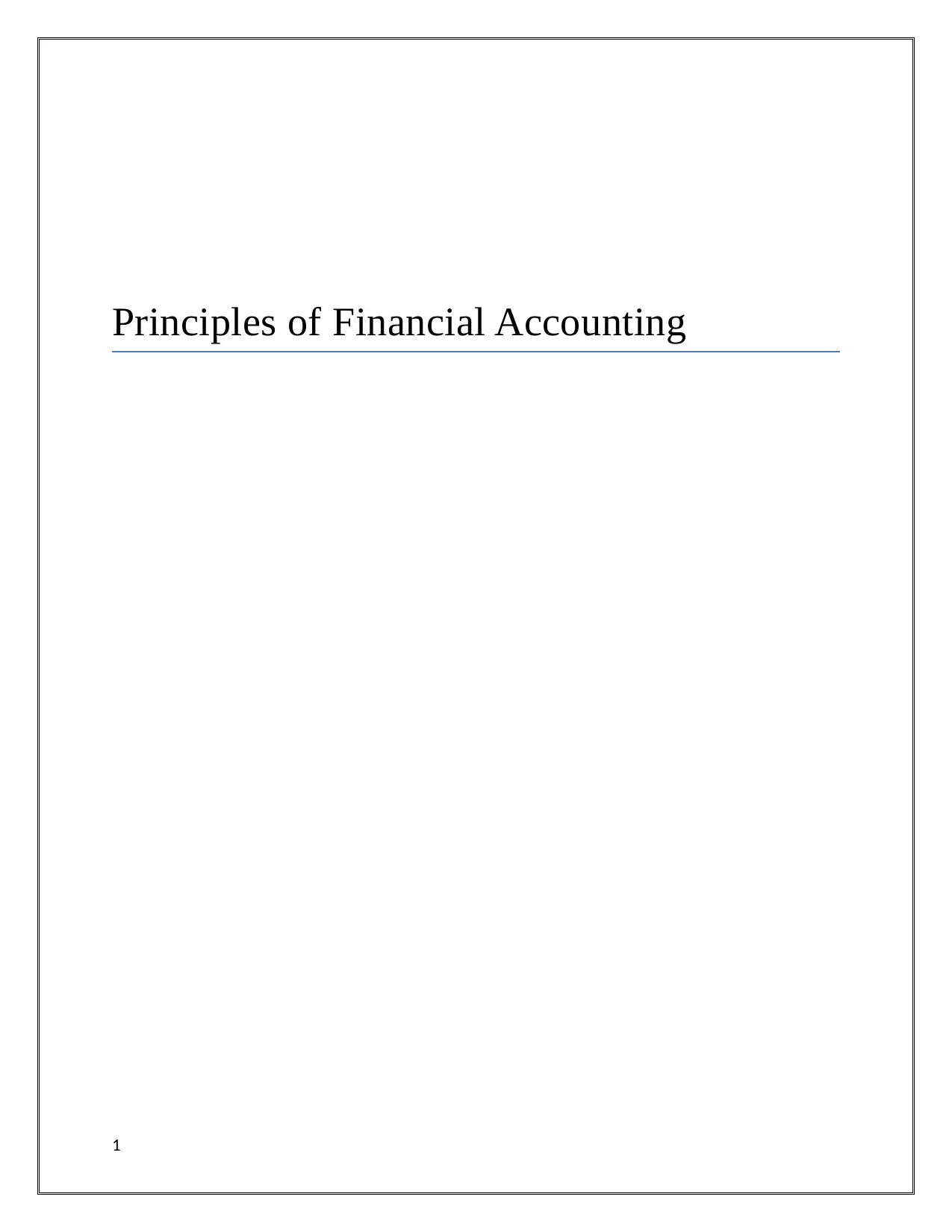
Principles of Financial Accounting
1
1
Secure Best Marks with AI Grader
Need help grading? Try our AI Grader for instant feedback on your assignments.
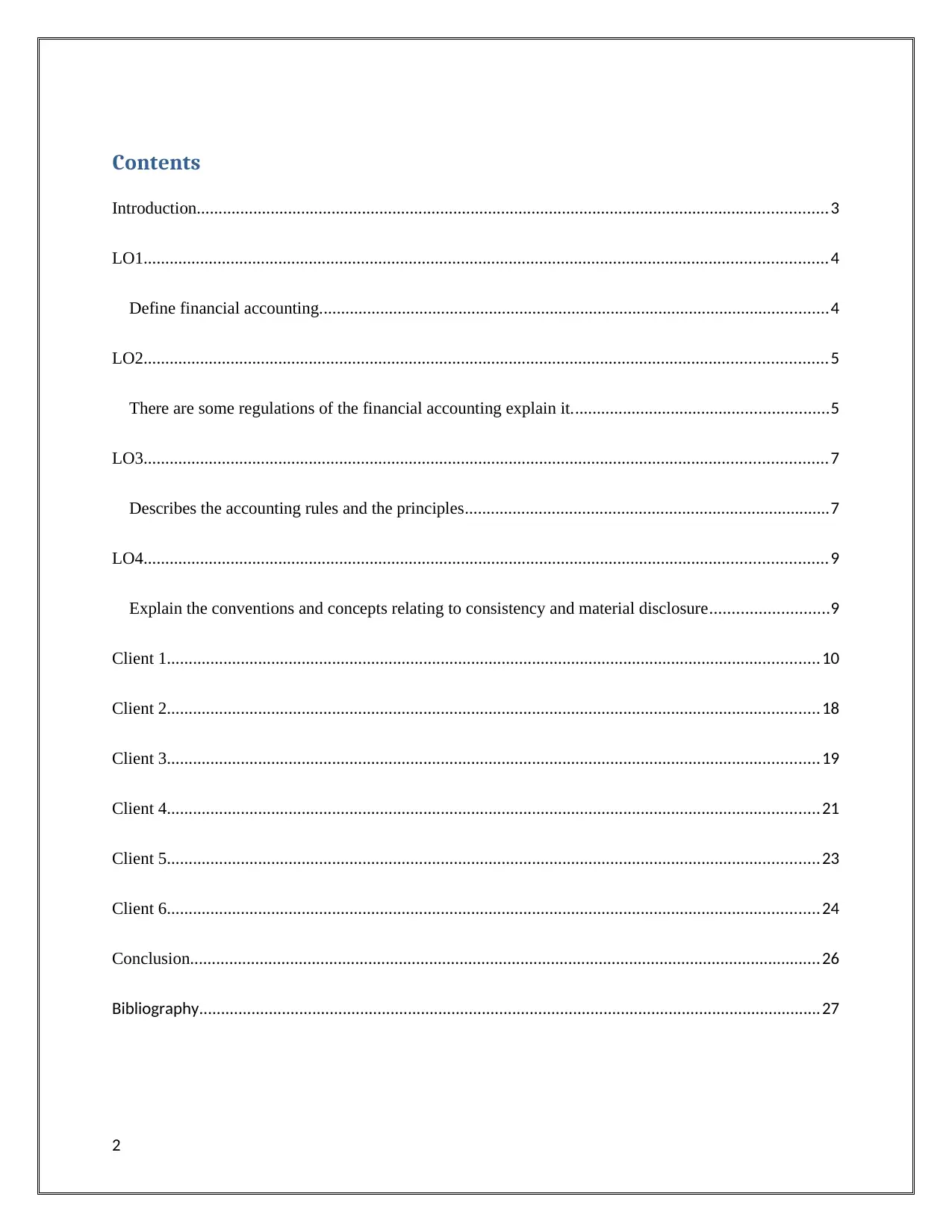
Contents
Introduction.................................................................................................................................................3
LO1.............................................................................................................................................................4
Define financial accounting.....................................................................................................................4
LO2.............................................................................................................................................................5
There are some regulations of the financial accounting explain it...........................................................5
LO3.............................................................................................................................................................7
Describes the accounting rules and the principles....................................................................................7
LO4.............................................................................................................................................................9
Explain the conventions and concepts relating to consistency and material disclosure...........................9
Client 1......................................................................................................................................................10
Client 2......................................................................................................................................................18
Client 3......................................................................................................................................................19
Client 4......................................................................................................................................................21
Client 5......................................................................................................................................................23
Client 6......................................................................................................................................................24
Conclusion.................................................................................................................................................26
Bibliography...............................................................................................................................................27
2
Introduction.................................................................................................................................................3
LO1.............................................................................................................................................................4
Define financial accounting.....................................................................................................................4
LO2.............................................................................................................................................................5
There are some regulations of the financial accounting explain it...........................................................5
LO3.............................................................................................................................................................7
Describes the accounting rules and the principles....................................................................................7
LO4.............................................................................................................................................................9
Explain the conventions and concepts relating to consistency and material disclosure...........................9
Client 1......................................................................................................................................................10
Client 2......................................................................................................................................................18
Client 3......................................................................................................................................................19
Client 4......................................................................................................................................................21
Client 5......................................................................................................................................................23
Client 6......................................................................................................................................................24
Conclusion.................................................................................................................................................26
Bibliography...............................................................................................................................................27
2
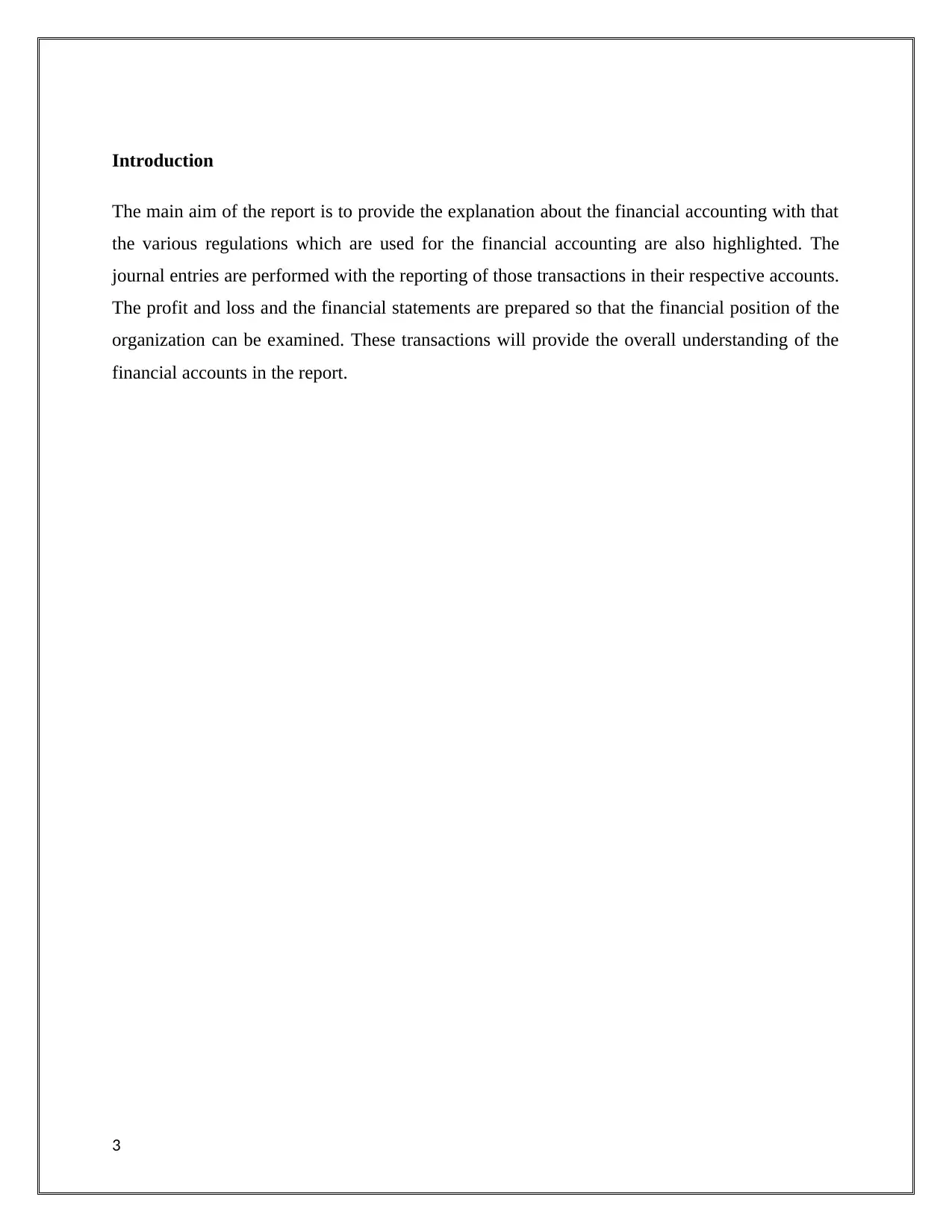
Introduction
The main aim of the report is to provide the explanation about the financial accounting with that
the various regulations which are used for the financial accounting are also highlighted. The
journal entries are performed with the reporting of those transactions in their respective accounts.
The profit and loss and the financial statements are prepared so that the financial position of the
organization can be examined. These transactions will provide the overall understanding of the
financial accounts in the report.
3
The main aim of the report is to provide the explanation about the financial accounting with that
the various regulations which are used for the financial accounting are also highlighted. The
journal entries are performed with the reporting of those transactions in their respective accounts.
The profit and loss and the financial statements are prepared so that the financial position of the
organization can be examined. These transactions will provide the overall understanding of the
financial accounts in the report.
3
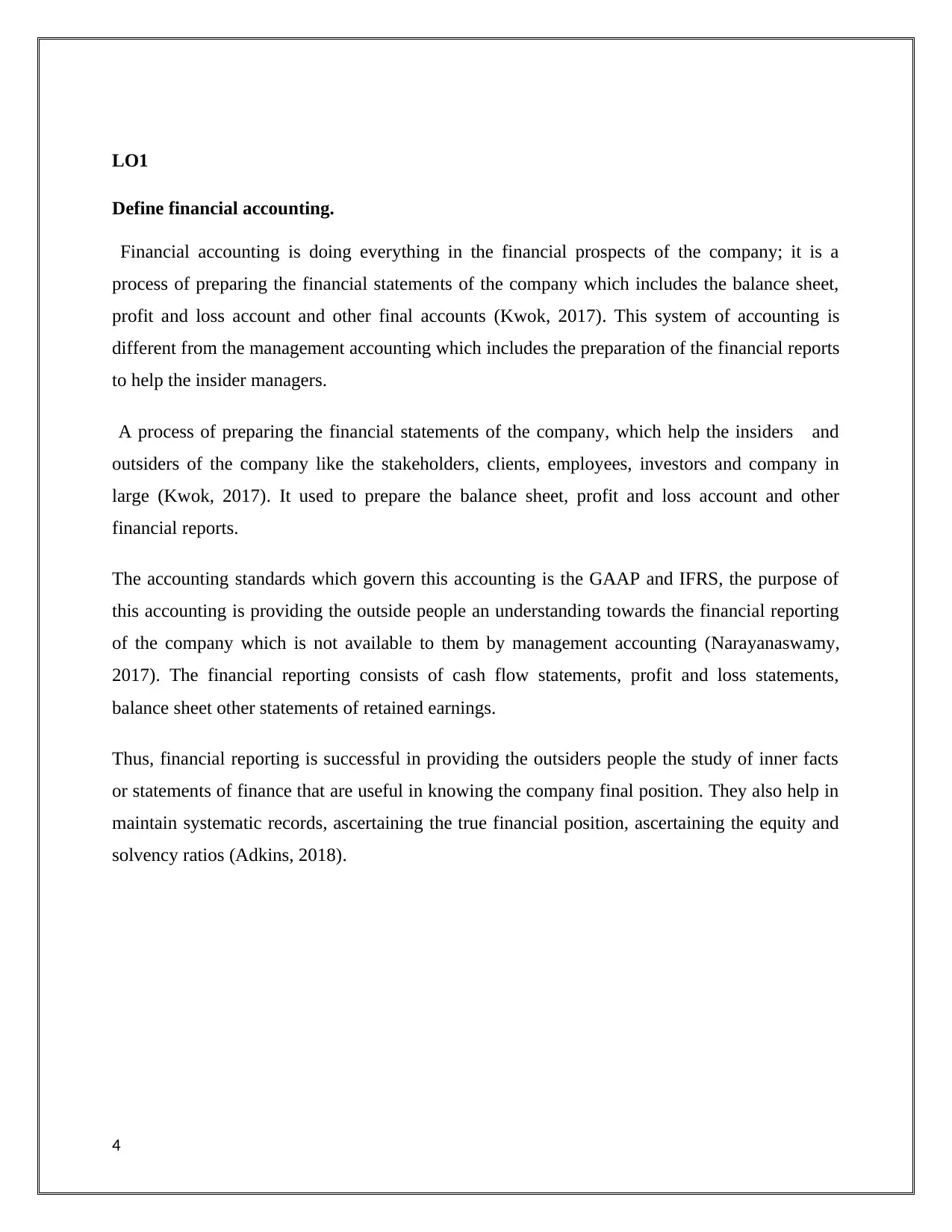
LO1
Define financial accounting.
Financial accounting is doing everything in the financial prospects of the company; it is a
process of preparing the financial statements of the company which includes the balance sheet,
profit and loss account and other final accounts (Kwok, 2017). This system of accounting is
different from the management accounting which includes the preparation of the financial reports
to help the insider managers.
A process of preparing the financial statements of the company, which help the insiders and
outsiders of the company like the stakeholders, clients, employees, investors and company in
large (Kwok, 2017). It used to prepare the balance sheet, profit and loss account and other
financial reports.
The accounting standards which govern this accounting is the GAAP and IFRS, the purpose of
this accounting is providing the outside people an understanding towards the financial reporting
of the company which is not available to them by management accounting (Narayanaswamy,
2017). The financial reporting consists of cash flow statements, profit and loss statements,
balance sheet other statements of retained earnings.
Thus, financial reporting is successful in providing the outsiders people the study of inner facts
or statements of finance that are useful in knowing the company final position. They also help in
maintain systematic records, ascertaining the true financial position, ascertaining the equity and
solvency ratios (Adkins, 2018).
4
Define financial accounting.
Financial accounting is doing everything in the financial prospects of the company; it is a
process of preparing the financial statements of the company which includes the balance sheet,
profit and loss account and other final accounts (Kwok, 2017). This system of accounting is
different from the management accounting which includes the preparation of the financial reports
to help the insider managers.
A process of preparing the financial statements of the company, which help the insiders and
outsiders of the company like the stakeholders, clients, employees, investors and company in
large (Kwok, 2017). It used to prepare the balance sheet, profit and loss account and other
financial reports.
The accounting standards which govern this accounting is the GAAP and IFRS, the purpose of
this accounting is providing the outside people an understanding towards the financial reporting
of the company which is not available to them by management accounting (Narayanaswamy,
2017). The financial reporting consists of cash flow statements, profit and loss statements,
balance sheet other statements of retained earnings.
Thus, financial reporting is successful in providing the outsiders people the study of inner facts
or statements of finance that are useful in knowing the company final position. They also help in
maintain systematic records, ascertaining the true financial position, ascertaining the equity and
solvency ratios (Adkins, 2018).
4
Secure Best Marks with AI Grader
Need help grading? Try our AI Grader for instant feedback on your assignments.
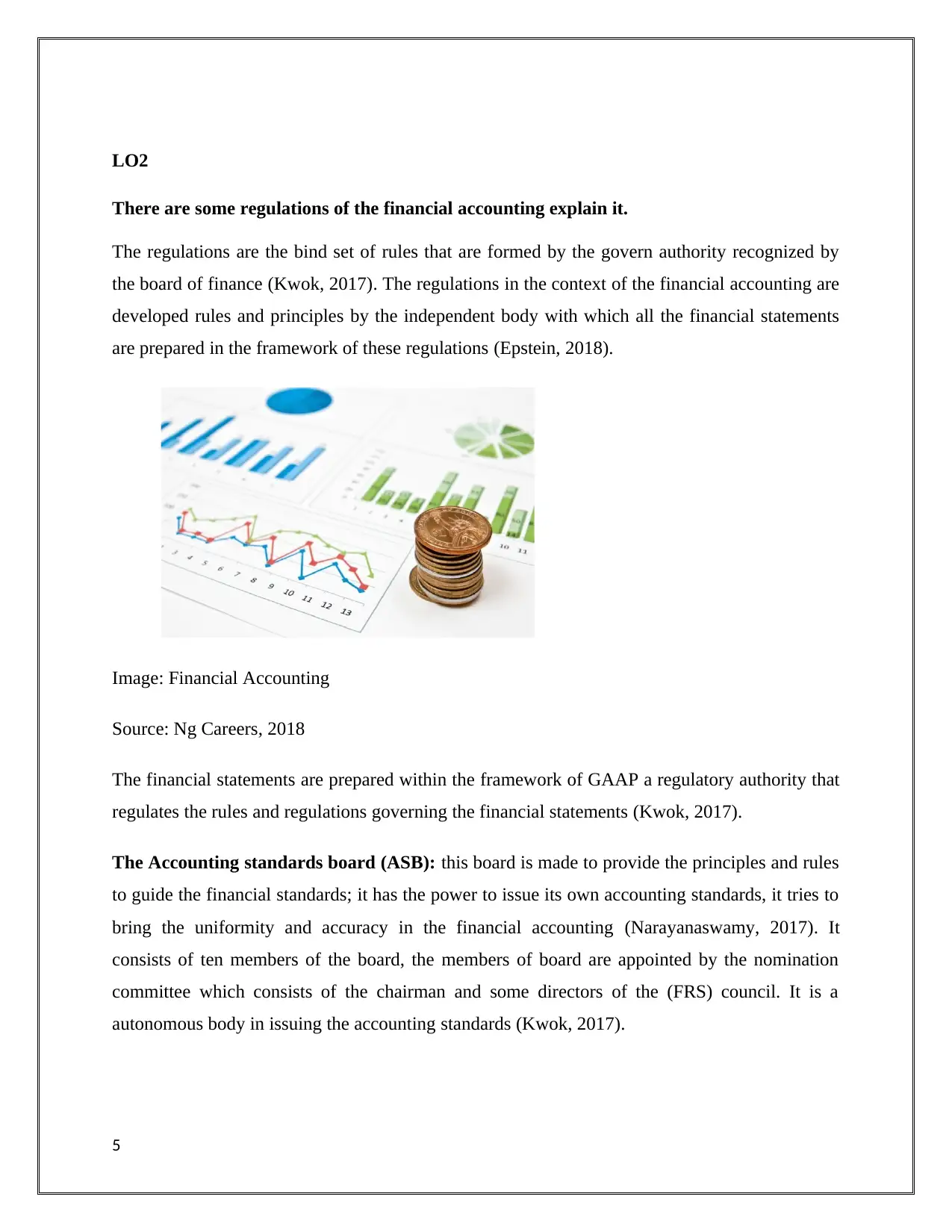
LO2
There are some regulations of the financial accounting explain it.
The regulations are the bind set of rules that are formed by the govern authority recognized by
the board of finance (Kwok, 2017). The regulations in the context of the financial accounting are
developed rules and principles by the independent body with which all the financial statements
are prepared in the framework of these regulations (Epstein, 2018).
Image: Financial Accounting
Source: Ng Careers, 2018
The financial statements are prepared within the framework of GAAP a regulatory authority that
regulates the rules and regulations governing the financial statements (Kwok, 2017).
The Accounting standards board (ASB): this board is made to provide the principles and rules
to guide the financial standards; it has the power to issue its own accounting standards, it tries to
bring the uniformity and accuracy in the financial accounting (Narayanaswamy, 2017). It
consists of ten members of the board, the members of board are appointed by the nomination
committee which consists of the chairman and some directors of the (FRS) council. It is a
autonomous body in issuing the accounting standards (Kwok, 2017).
5
There are some regulations of the financial accounting explain it.
The regulations are the bind set of rules that are formed by the govern authority recognized by
the board of finance (Kwok, 2017). The regulations in the context of the financial accounting are
developed rules and principles by the independent body with which all the financial statements
are prepared in the framework of these regulations (Epstein, 2018).
Image: Financial Accounting
Source: Ng Careers, 2018
The financial statements are prepared within the framework of GAAP a regulatory authority that
regulates the rules and regulations governing the financial statements (Kwok, 2017).
The Accounting standards board (ASB): this board is made to provide the principles and rules
to guide the financial standards; it has the power to issue its own accounting standards, it tries to
bring the uniformity and accuracy in the financial accounting (Narayanaswamy, 2017). It
consists of ten members of the board, the members of board are appointed by the nomination
committee which consists of the chairman and some directors of the (FRS) council. It is a
autonomous body in issuing the accounting standards (Kwok, 2017).
5
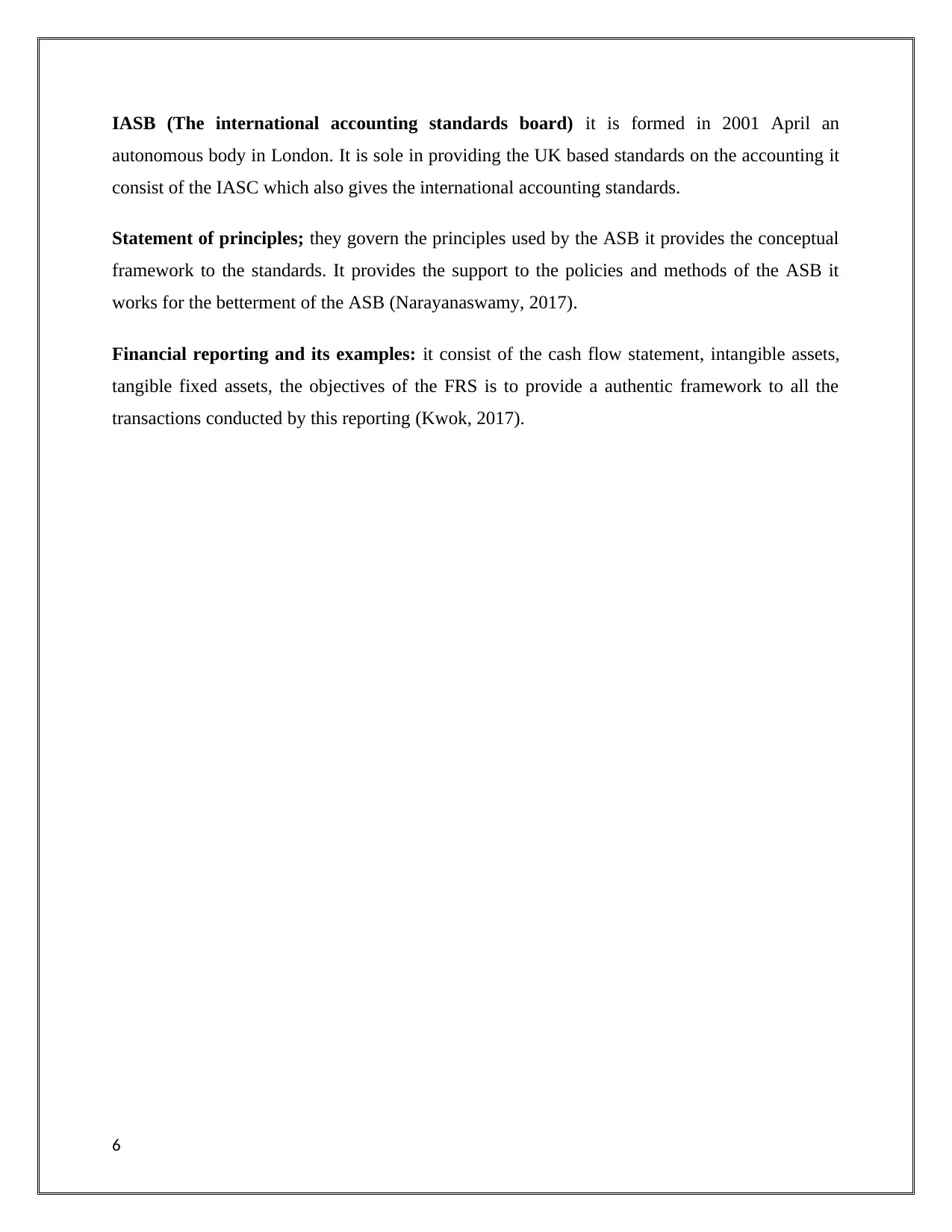
IASB (The international accounting standards board) it is formed in 2001 April an
autonomous body in London. It is sole in providing the UK based standards on the accounting it
consist of the IASC which also gives the international accounting standards.
Statement of principles; they govern the principles used by the ASB it provides the conceptual
framework to the standards. It provides the support to the policies and methods of the ASB it
works for the betterment of the ASB (Narayanaswamy, 2017).
Financial reporting and its examples: it consist of the cash flow statement, intangible assets,
tangible fixed assets, the objectives of the FRS is to provide a authentic framework to all the
transactions conducted by this reporting (Kwok, 2017).
6
autonomous body in London. It is sole in providing the UK based standards on the accounting it
consist of the IASC which also gives the international accounting standards.
Statement of principles; they govern the principles used by the ASB it provides the conceptual
framework to the standards. It provides the support to the policies and methods of the ASB it
works for the betterment of the ASB (Narayanaswamy, 2017).
Financial reporting and its examples: it consist of the cash flow statement, intangible assets,
tangible fixed assets, the objectives of the FRS is to provide a authentic framework to all the
transactions conducted by this reporting (Kwok, 2017).
6
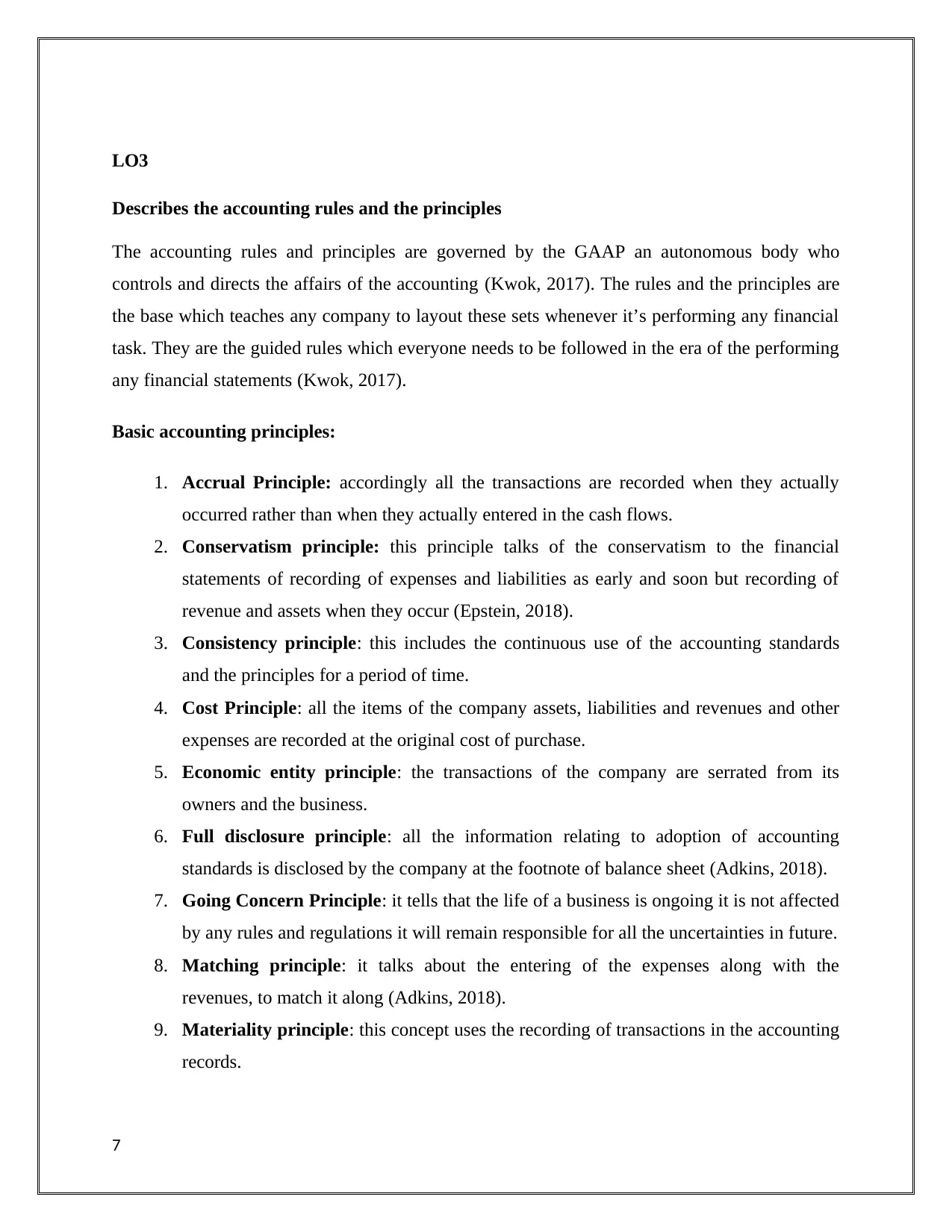
LO3
Describes the accounting rules and the principles
The accounting rules and principles are governed by the GAAP an autonomous body who
controls and directs the affairs of the accounting (Kwok, 2017). The rules and the principles are
the base which teaches any company to layout these sets whenever it’s performing any financial
task. They are the guided rules which everyone needs to be followed in the era of the performing
any financial statements (Kwok, 2017).
Basic accounting principles:
1. Accrual Principle: accordingly all the transactions are recorded when they actually
occurred rather than when they actually entered in the cash flows.
2. Conservatism principle: this principle talks of the conservatism to the financial
statements of recording of expenses and liabilities as early and soon but recording of
revenue and assets when they occur (Epstein, 2018).
3. Consistency principle: this includes the continuous use of the accounting standards
and the principles for a period of time.
4. Cost Principle: all the items of the company assets, liabilities and revenues and other
expenses are recorded at the original cost of purchase.
5. Economic entity principle: the transactions of the company are serrated from its
owners and the business.
6. Full disclosure principle: all the information relating to adoption of accounting
standards is disclosed by the company at the footnote of balance sheet (Adkins, 2018).
7. Going Concern Principle: it tells that the life of a business is ongoing it is not affected
by any rules and regulations it will remain responsible for all the uncertainties in future.
8. Matching principle: it talks about the entering of the expenses along with the
revenues, to match it along (Adkins, 2018).
9. Materiality principle: this concept uses the recording of transactions in the accounting
records.
7
Describes the accounting rules and the principles
The accounting rules and principles are governed by the GAAP an autonomous body who
controls and directs the affairs of the accounting (Kwok, 2017). The rules and the principles are
the base which teaches any company to layout these sets whenever it’s performing any financial
task. They are the guided rules which everyone needs to be followed in the era of the performing
any financial statements (Kwok, 2017).
Basic accounting principles:
1. Accrual Principle: accordingly all the transactions are recorded when they actually
occurred rather than when they actually entered in the cash flows.
2. Conservatism principle: this principle talks of the conservatism to the financial
statements of recording of expenses and liabilities as early and soon but recording of
revenue and assets when they occur (Epstein, 2018).
3. Consistency principle: this includes the continuous use of the accounting standards
and the principles for a period of time.
4. Cost Principle: all the items of the company assets, liabilities and revenues and other
expenses are recorded at the original cost of purchase.
5. Economic entity principle: the transactions of the company are serrated from its
owners and the business.
6. Full disclosure principle: all the information relating to adoption of accounting
standards is disclosed by the company at the footnote of balance sheet (Adkins, 2018).
7. Going Concern Principle: it tells that the life of a business is ongoing it is not affected
by any rules and regulations it will remain responsible for all the uncertainties in future.
8. Matching principle: it talks about the entering of the expenses along with the
revenues, to match it along (Adkins, 2018).
9. Materiality principle: this concept uses the recording of transactions in the accounting
records.
7
Paraphrase This Document
Need a fresh take? Get an instant paraphrase of this document with our AI Paraphraser
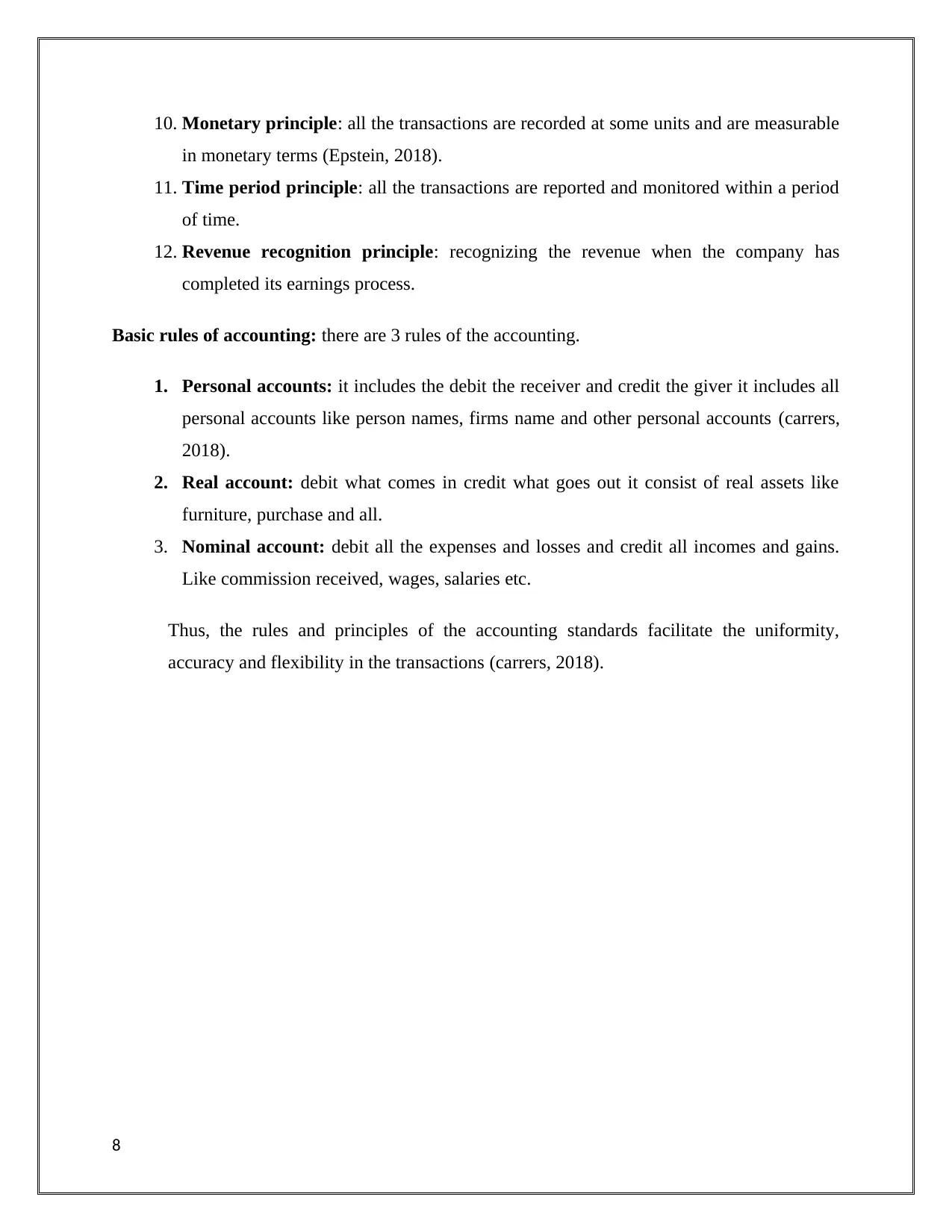
10. Monetary principle: all the transactions are recorded at some units and are measurable
in monetary terms (Epstein, 2018).
11. Time period principle: all the transactions are reported and monitored within a period
of time.
12. Revenue recognition principle: recognizing the revenue when the company has
completed its earnings process.
Basic rules of accounting: there are 3 rules of the accounting.
1. Personal accounts: it includes the debit the receiver and credit the giver it includes all
personal accounts like person names, firms name and other personal accounts (carrers,
2018).
2. Real account: debit what comes in credit what goes out it consist of real assets like
furniture, purchase and all.
3. Nominal account: debit all the expenses and losses and credit all incomes and gains.
Like commission received, wages, salaries etc.
Thus, the rules and principles of the accounting standards facilitate the uniformity,
accuracy and flexibility in the transactions (carrers, 2018).
8
in monetary terms (Epstein, 2018).
11. Time period principle: all the transactions are reported and monitored within a period
of time.
12. Revenue recognition principle: recognizing the revenue when the company has
completed its earnings process.
Basic rules of accounting: there are 3 rules of the accounting.
1. Personal accounts: it includes the debit the receiver and credit the giver it includes all
personal accounts like person names, firms name and other personal accounts (carrers,
2018).
2. Real account: debit what comes in credit what goes out it consist of real assets like
furniture, purchase and all.
3. Nominal account: debit all the expenses and losses and credit all incomes and gains.
Like commission received, wages, salaries etc.
Thus, the rules and principles of the accounting standards facilitate the uniformity,
accuracy and flexibility in the transactions (carrers, 2018).
8
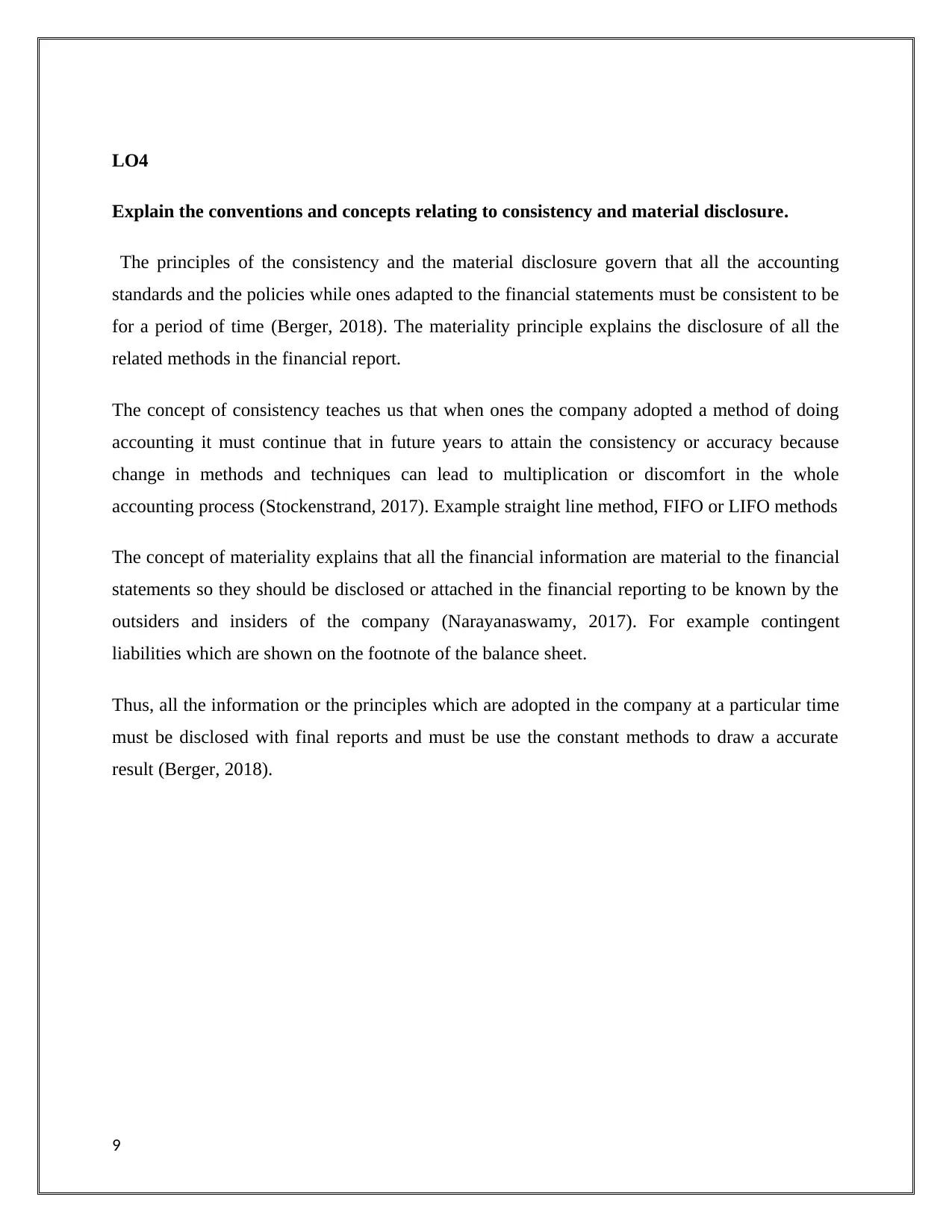
LO4
Explain the conventions and concepts relating to consistency and material disclosure.
The principles of the consistency and the material disclosure govern that all the accounting
standards and the policies while ones adapted to the financial statements must be consistent to be
for a period of time (Berger, 2018). The materiality principle explains the disclosure of all the
related methods in the financial report.
The concept of consistency teaches us that when ones the company adopted a method of doing
accounting it must continue that in future years to attain the consistency or accuracy because
change in methods and techniques can lead to multiplication or discomfort in the whole
accounting process (Stockenstrand, 2017). Example straight line method, FIFO or LIFO methods
The concept of materiality explains that all the financial information are material to the financial
statements so they should be disclosed or attached in the financial reporting to be known by the
outsiders and insiders of the company (Narayanaswamy, 2017). For example contingent
liabilities which are shown on the footnote of the balance sheet.
Thus, all the information or the principles which are adopted in the company at a particular time
must be disclosed with final reports and must be use the constant methods to draw a accurate
result (Berger, 2018).
9
Explain the conventions and concepts relating to consistency and material disclosure.
The principles of the consistency and the material disclosure govern that all the accounting
standards and the policies while ones adapted to the financial statements must be consistent to be
for a period of time (Berger, 2018). The materiality principle explains the disclosure of all the
related methods in the financial report.
The concept of consistency teaches us that when ones the company adopted a method of doing
accounting it must continue that in future years to attain the consistency or accuracy because
change in methods and techniques can lead to multiplication or discomfort in the whole
accounting process (Stockenstrand, 2017). Example straight line method, FIFO or LIFO methods
The concept of materiality explains that all the financial information are material to the financial
statements so they should be disclosed or attached in the financial reporting to be known by the
outsiders and insiders of the company (Narayanaswamy, 2017). For example contingent
liabilities which are shown on the footnote of the balance sheet.
Thus, all the information or the principles which are adopted in the company at a particular time
must be disclosed with final reports and must be use the constant methods to draw a accurate
result (Berger, 2018).
9

Client 1
I. The book of Prime entry
Calculation of Owner's Capital
Particulars Amount
Assets:
Van 51250
Premises 340000
Fixture 8100
Receivables 4500
Inventory 63900
Cash at Bank 62400
Cash in Hand 5600
Total Assets 484500
Liabilities:
Payables 6750
Total Liabilities 6750
Owner's Equity 477750
Journal Entries
In the books of Alexandra
For the Year ended January 2018
Date Particular LF Debit Credit
1-Jan-
18
Storage Expenses A/C
Dr. 400
To Bank A/C 400
(For Storage Cost paid by Cheque)
2-Jan-
18
Purchases A/C
Dr. 6080
To S. Hood 1450
To D. Main 2060
To W. Tone 960
To R. Foot 1610
(Being goods purchased on credit)
3-Jan- J. Wilson A/C 1120
10
I. The book of Prime entry
Calculation of Owner's Capital
Particulars Amount
Assets:
Van 51250
Premises 340000
Fixture 8100
Receivables 4500
Inventory 63900
Cash at Bank 62400
Cash in Hand 5600
Total Assets 484500
Liabilities:
Payables 6750
Total Liabilities 6750
Owner's Equity 477750
Journal Entries
In the books of Alexandra
For the Year ended January 2018
Date Particular LF Debit Credit
1-Jan-
18
Storage Expenses A/C
Dr. 400
To Bank A/C 400
(For Storage Cost paid by Cheque)
2-Jan-
18
Purchases A/C
Dr. 6080
To S. Hood 1450
To D. Main 2060
To W. Tone 960
To R. Foot 1610
(Being goods purchased on credit)
3-Jan- J. Wilson A/C 1120
10
Secure Best Marks with AI Grader
Need help grading? Try our AI Grader for instant feedback on your assignments.
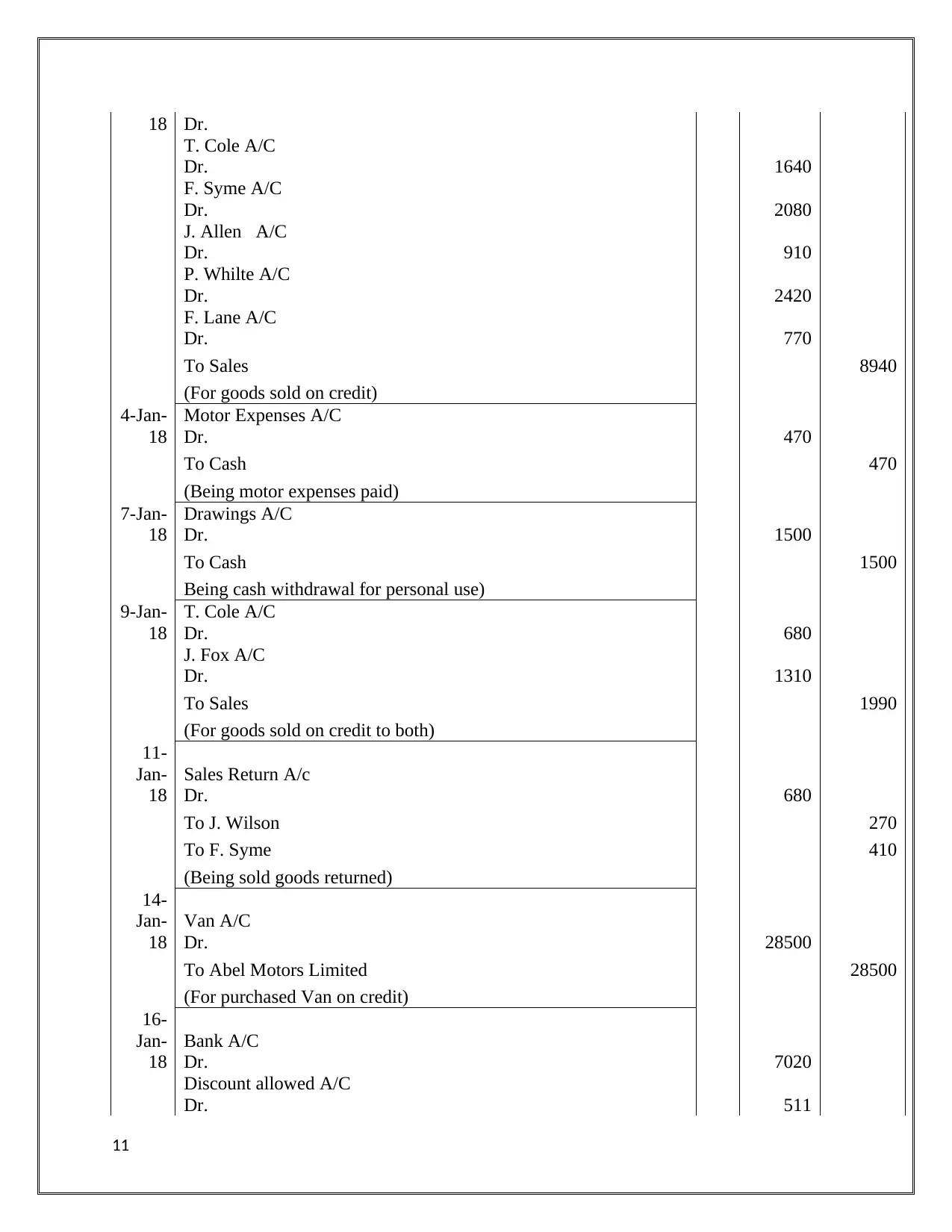
18 Dr.
T. Cole A/C
Dr. 1640
F. Syme A/C
Dr. 2080
J. Allen A/C
Dr. 910
P. Whilte A/C
Dr. 2420
F. Lane A/C
Dr. 770
To Sales 8940
(For goods sold on credit)
4-Jan-
18
Motor Expenses A/C
Dr. 470
To Cash 470
(Being motor expenses paid)
7-Jan-
18
Drawings A/C
Dr. 1500
To Cash 1500
Being cash withdrawal for personal use)
9-Jan-
18
T. Cole A/C
Dr. 680
J. Fox A/C
Dr. 1310
To Sales 1990
(For goods sold on credit to both)
11-
Jan-
18
Sales Return A/c
Dr. 680
To J. Wilson 270
To F. Syme 410
(Being sold goods returned)
14-
Jan-
18
Van A/C
Dr. 28500
To Abel Motors Limited 28500
(For purchased Van on credit)
16-
Jan-
18
Bank A/C
Dr. 7020
Discount allowed A/C
Dr. 511
11
T. Cole A/C
Dr. 1640
F. Syme A/C
Dr. 2080
J. Allen A/C
Dr. 910
P. Whilte A/C
Dr. 2420
F. Lane A/C
Dr. 770
To Sales 8940
(For goods sold on credit)
4-Jan-
18
Motor Expenses A/C
Dr. 470
To Cash 470
(Being motor expenses paid)
7-Jan-
18
Drawings A/C
Dr. 1500
To Cash 1500
Being cash withdrawal for personal use)
9-Jan-
18
T. Cole A/C
Dr. 680
J. Fox A/C
Dr. 1310
To Sales 1990
(For goods sold on credit to both)
11-
Jan-
18
Sales Return A/c
Dr. 680
To J. Wilson 270
To F. Syme 410
(Being sold goods returned)
14-
Jan-
18
Van A/C
Dr. 28500
To Abel Motors Limited 28500
(For purchased Van on credit)
16-
Jan-
18
Bank A/C
Dr. 7020
Discount allowed A/C
Dr. 511
11
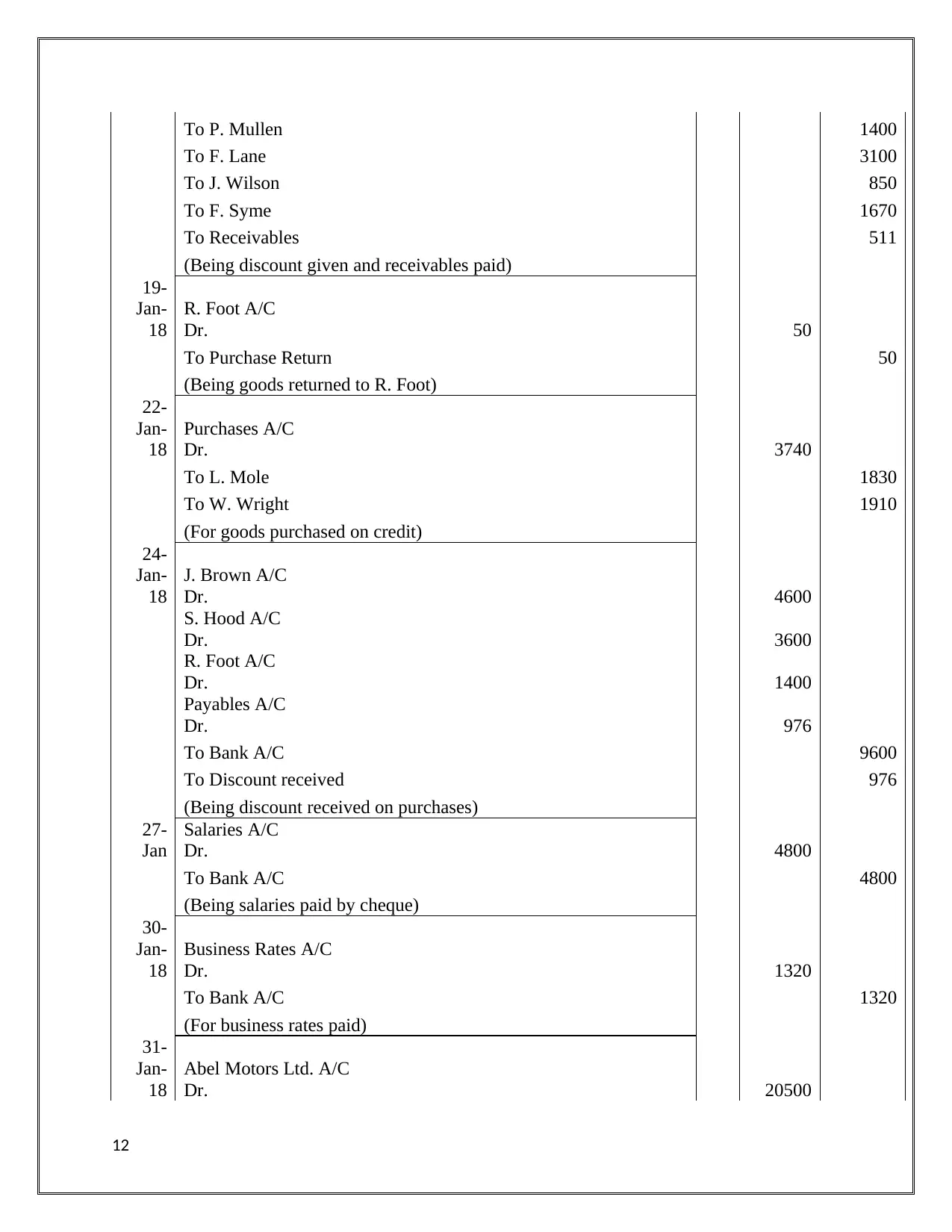
To P. Mullen 1400
To F. Lane 3100
To J. Wilson 850
To F. Syme 1670
To Receivables 511
(Being discount given and receivables paid)
19-
Jan-
18
R. Foot A/C
Dr. 50
To Purchase Return 50
(Being goods returned to R. Foot)
22-
Jan-
18
Purchases A/C
Dr. 3740
To L. Mole 1830
To W. Wright 1910
(For goods purchased on credit)
24-
Jan-
18
J. Brown A/C
Dr. 4600
S. Hood A/C
Dr. 3600
R. Foot A/C
Dr. 1400
Payables A/C
Dr. 976
To Bank A/C 9600
To Discount received 976
(Being discount received on purchases)
27-
Jan
Salaries A/C
Dr. 4800
To Bank A/C 4800
(Being salaries paid by cheque)
30-
Jan-
18
Business Rates A/C
Dr. 1320
To Bank A/C 1320
(For business rates paid)
31-
Jan-
18
Abel Motors Ltd. A/C
Dr. 20500
12
To F. Lane 3100
To J. Wilson 850
To F. Syme 1670
To Receivables 511
(Being discount given and receivables paid)
19-
Jan-
18
R. Foot A/C
Dr. 50
To Purchase Return 50
(Being goods returned to R. Foot)
22-
Jan-
18
Purchases A/C
Dr. 3740
To L. Mole 1830
To W. Wright 1910
(For goods purchased on credit)
24-
Jan-
18
J. Brown A/C
Dr. 4600
S. Hood A/C
Dr. 3600
R. Foot A/C
Dr. 1400
Payables A/C
Dr. 976
To Bank A/C 9600
To Discount received 976
(Being discount received on purchases)
27-
Jan
Salaries A/C
Dr. 4800
To Bank A/C 4800
(Being salaries paid by cheque)
30-
Jan-
18
Business Rates A/C
Dr. 1320
To Bank A/C 1320
(For business rates paid)
31-
Jan-
18
Abel Motors Ltd. A/C
Dr. 20500
12

To Bank A/C 20500
(For paid to Abel Motors)
Total 97077 97077
II. Complete double entry recording within the ledgers
Purchases A/C
Date Particulars Debit Date Particulars Credit
2-Jan-18 To payables 6080
31-Jan-
18 By Balance c/d 9820
22-Jan-
18 To payables 3740
Total 9820 Total 9820
1-Feb-18 To balance b/d 9820
Sales A/C
Date Particulars Debit Date Particulars Credit
31-Jan-18 To Balance c/d 10930 3-Jan-18 By Receivables 8940
9-Jan-18 By Receivables 1990
Total 10930 Total 10930
1-Feb-
18 By balance b/d 10930
Storage Expenses A/C
Date Particulars Debit Date Particulars Credit
1-Jan-18 To Bank A/C 400 31-Jan-18 By Balance c/d 400
Total 400 Total 400
1-Feb-18 To balance b/d 400
Cash A/C
Date Particulars Debit Date Particulars Credit
1-Feb-18 To Balance b/d 5600 4-Jan-18 By Motor Expenses 470
7-Jan-18 By Drawings 1500
31-Jan-18 By Balance c/d 3630
13
(For paid to Abel Motors)
Total 97077 97077
II. Complete double entry recording within the ledgers
Purchases A/C
Date Particulars Debit Date Particulars Credit
2-Jan-18 To payables 6080
31-Jan-
18 By Balance c/d 9820
22-Jan-
18 To payables 3740
Total 9820 Total 9820
1-Feb-18 To balance b/d 9820
Sales A/C
Date Particulars Debit Date Particulars Credit
31-Jan-18 To Balance c/d 10930 3-Jan-18 By Receivables 8940
9-Jan-18 By Receivables 1990
Total 10930 Total 10930
1-Feb-
18 By balance b/d 10930
Storage Expenses A/C
Date Particulars Debit Date Particulars Credit
1-Jan-18 To Bank A/C 400 31-Jan-18 By Balance c/d 400
Total 400 Total 400
1-Feb-18 To balance b/d 400
Cash A/C
Date Particulars Debit Date Particulars Credit
1-Feb-18 To Balance b/d 5600 4-Jan-18 By Motor Expenses 470
7-Jan-18 By Drawings 1500
31-Jan-18 By Balance c/d 3630
13
Paraphrase This Document
Need a fresh take? Get an instant paraphrase of this document with our AI Paraphraser
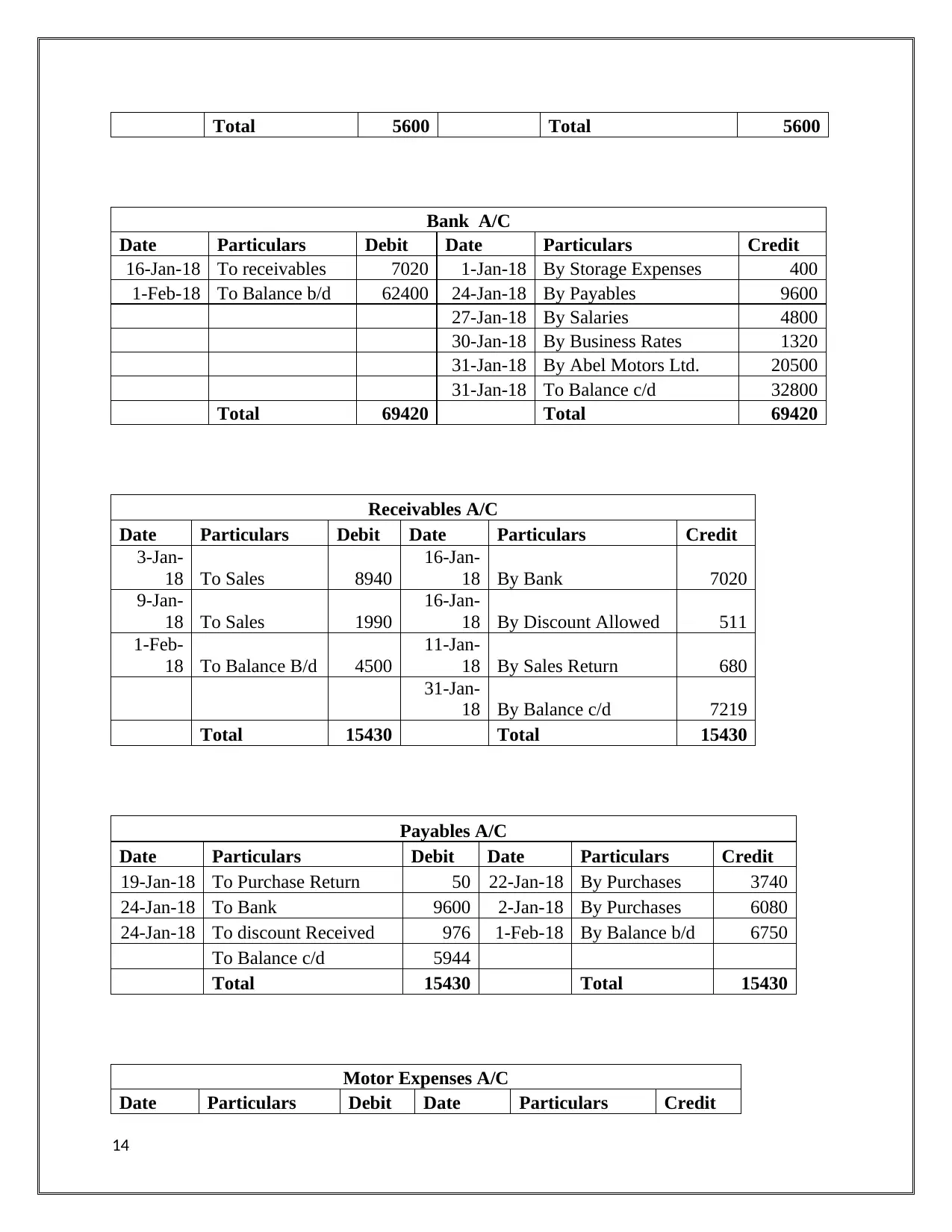
Total 5600 Total 5600
Bank A/C
Date Particulars Debit Date Particulars Credit
16-Jan-18 To receivables 7020 1-Jan-18 By Storage Expenses 400
1-Feb-18 To Balance b/d 62400 24-Jan-18 By Payables 9600
27-Jan-18 By Salaries 4800
30-Jan-18 By Business Rates 1320
31-Jan-18 By Abel Motors Ltd. 20500
31-Jan-18 To Balance c/d 32800
Total 69420 Total 69420
Receivables A/C
Date Particulars Debit Date Particulars Credit
3-Jan-
18 To Sales 8940
16-Jan-
18 By Bank 7020
9-Jan-
18 To Sales 1990
16-Jan-
18 By Discount Allowed 511
1-Feb-
18 To Balance B/d 4500
11-Jan-
18 By Sales Return 680
31-Jan-
18 By Balance c/d 7219
Total 15430 Total 15430
Payables A/C
Date Particulars Debit Date Particulars Credit
19-Jan-18 To Purchase Return 50 22-Jan-18 By Purchases 3740
24-Jan-18 To Bank 9600 2-Jan-18 By Purchases 6080
24-Jan-18 To discount Received 976 1-Feb-18 By Balance b/d 6750
To Balance c/d 5944
Total 15430 Total 15430
Motor Expenses A/C
Date Particulars Debit Date Particulars Credit
14
Bank A/C
Date Particulars Debit Date Particulars Credit
16-Jan-18 To receivables 7020 1-Jan-18 By Storage Expenses 400
1-Feb-18 To Balance b/d 62400 24-Jan-18 By Payables 9600
27-Jan-18 By Salaries 4800
30-Jan-18 By Business Rates 1320
31-Jan-18 By Abel Motors Ltd. 20500
31-Jan-18 To Balance c/d 32800
Total 69420 Total 69420
Receivables A/C
Date Particulars Debit Date Particulars Credit
3-Jan-
18 To Sales 8940
16-Jan-
18 By Bank 7020
9-Jan-
18 To Sales 1990
16-Jan-
18 By Discount Allowed 511
1-Feb-
18 To Balance B/d 4500
11-Jan-
18 By Sales Return 680
31-Jan-
18 By Balance c/d 7219
Total 15430 Total 15430
Payables A/C
Date Particulars Debit Date Particulars Credit
19-Jan-18 To Purchase Return 50 22-Jan-18 By Purchases 3740
24-Jan-18 To Bank 9600 2-Jan-18 By Purchases 6080
24-Jan-18 To discount Received 976 1-Feb-18 By Balance b/d 6750
To Balance c/d 5944
Total 15430 Total 15430
Motor Expenses A/C
Date Particulars Debit Date Particulars Credit
14
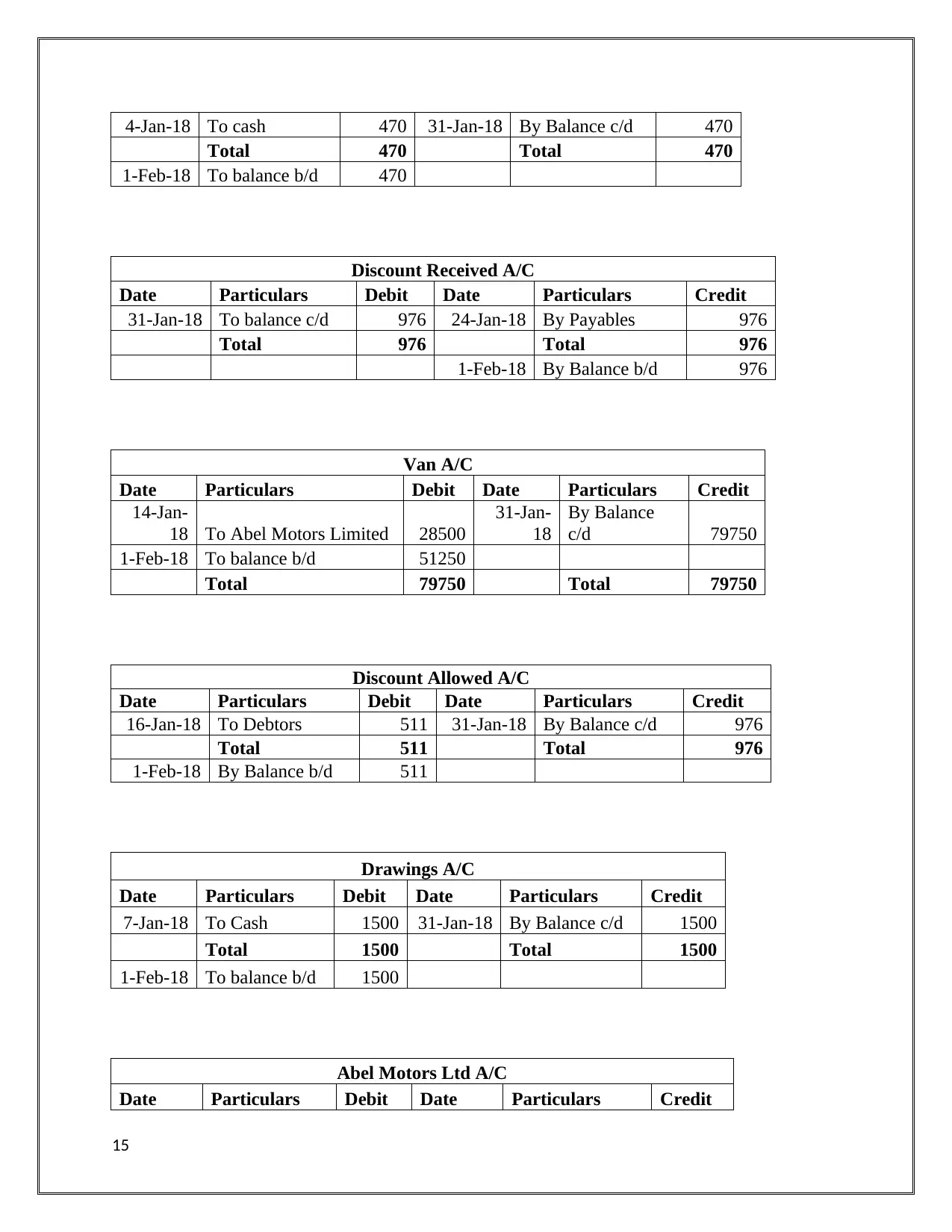
4-Jan-18 To cash 470 31-Jan-18 By Balance c/d 470
Total 470 Total 470
1-Feb-18 To balance b/d 470
Discount Received A/C
Date Particulars Debit Date Particulars Credit
31-Jan-18 To balance c/d 976 24-Jan-18 By Payables 976
Total 976 Total 976
1-Feb-18 By Balance b/d 976
Van A/C
Date Particulars Debit Date Particulars Credit
14-Jan-
18 To Abel Motors Limited 28500
31-Jan-
18
By Balance
c/d 79750
1-Feb-18 To balance b/d 51250
Total 79750 Total 79750
Discount Allowed A/C
Date Particulars Debit Date Particulars Credit
16-Jan-18 To Debtors 511 31-Jan-18 By Balance c/d 976
Total 511 Total 976
1-Feb-18 By Balance b/d 511
Drawings A/C
Date Particulars Debit Date Particulars Credit
7-Jan-18 To Cash 1500 31-Jan-18 By Balance c/d 1500
Total 1500 Total 1500
1-Feb-18 To balance b/d 1500
Abel Motors Ltd A/C
Date Particulars Debit Date Particulars Credit
15
Total 470 Total 470
1-Feb-18 To balance b/d 470
Discount Received A/C
Date Particulars Debit Date Particulars Credit
31-Jan-18 To balance c/d 976 24-Jan-18 By Payables 976
Total 976 Total 976
1-Feb-18 By Balance b/d 976
Van A/C
Date Particulars Debit Date Particulars Credit
14-Jan-
18 To Abel Motors Limited 28500
31-Jan-
18
By Balance
c/d 79750
1-Feb-18 To balance b/d 51250
Total 79750 Total 79750
Discount Allowed A/C
Date Particulars Debit Date Particulars Credit
16-Jan-18 To Debtors 511 31-Jan-18 By Balance c/d 976
Total 511 Total 976
1-Feb-18 By Balance b/d 511
Drawings A/C
Date Particulars Debit Date Particulars Credit
7-Jan-18 To Cash 1500 31-Jan-18 By Balance c/d 1500
Total 1500 Total 1500
1-Feb-18 To balance b/d 1500
Abel Motors Ltd A/C
Date Particulars Debit Date Particulars Credit
15
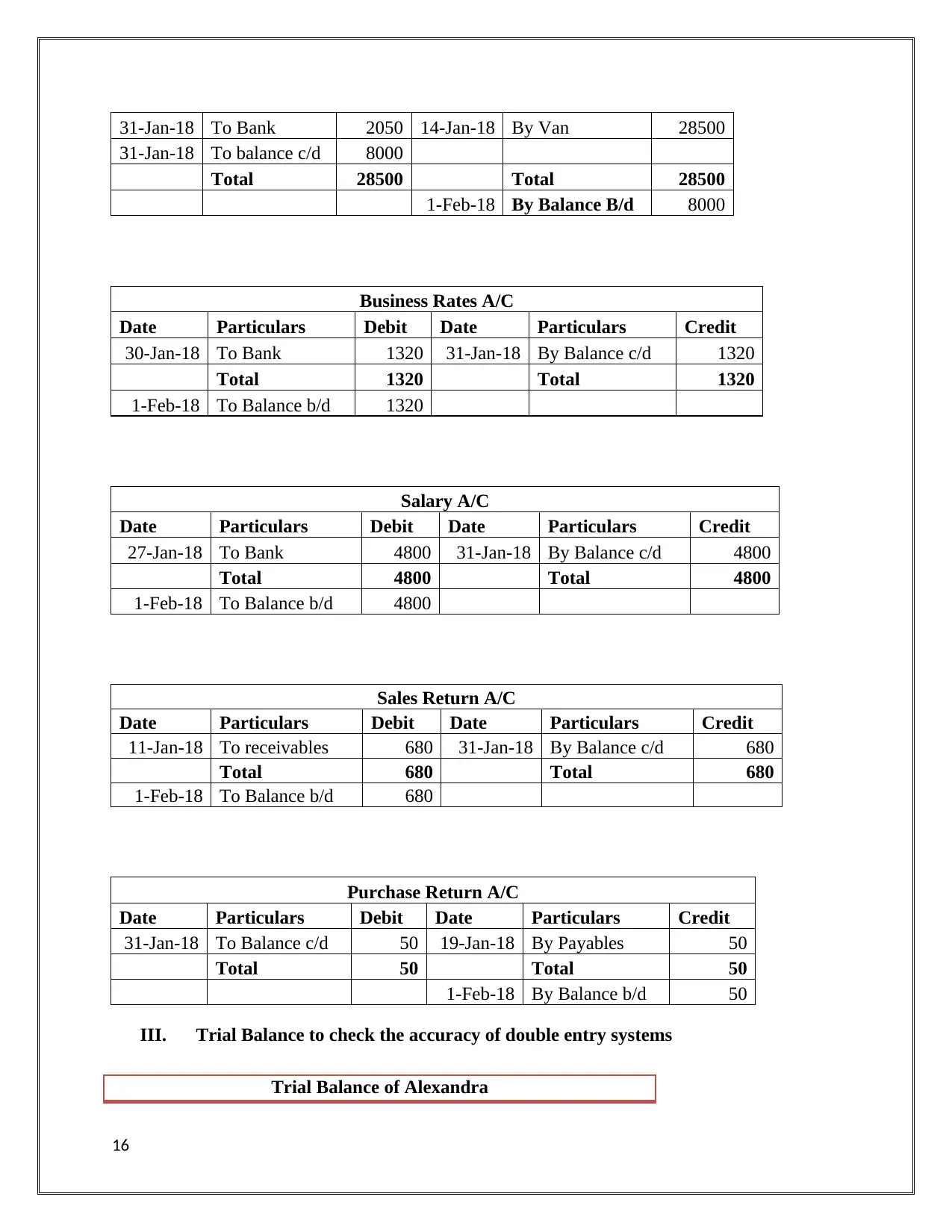
31-Jan-18 To Bank 2050 14-Jan-18 By Van 28500
31-Jan-18 To balance c/d 8000
Total 28500 Total 28500
1-Feb-18 By Balance B/d 8000
Business Rates A/C
Date Particulars Debit Date Particulars Credit
30-Jan-18 To Bank 1320 31-Jan-18 By Balance c/d 1320
Total 1320 Total 1320
1-Feb-18 To Balance b/d 1320
Salary A/C
Date Particulars Debit Date Particulars Credit
27-Jan-18 To Bank 4800 31-Jan-18 By Balance c/d 4800
Total 4800 Total 4800
1-Feb-18 To Balance b/d 4800
Sales Return A/C
Date Particulars Debit Date Particulars Credit
11-Jan-18 To receivables 680 31-Jan-18 By Balance c/d 680
Total 680 Total 680
1-Feb-18 To Balance b/d 680
Purchase Return A/C
Date Particulars Debit Date Particulars Credit
31-Jan-18 To Balance c/d 50 19-Jan-18 By Payables 50
Total 50 Total 50
1-Feb-18 By Balance b/d 50
III. Trial Balance to check the accuracy of double entry systems
Trial Balance of Alexandra
16
31-Jan-18 To balance c/d 8000
Total 28500 Total 28500
1-Feb-18 By Balance B/d 8000
Business Rates A/C
Date Particulars Debit Date Particulars Credit
30-Jan-18 To Bank 1320 31-Jan-18 By Balance c/d 1320
Total 1320 Total 1320
1-Feb-18 To Balance b/d 1320
Salary A/C
Date Particulars Debit Date Particulars Credit
27-Jan-18 To Bank 4800 31-Jan-18 By Balance c/d 4800
Total 4800 Total 4800
1-Feb-18 To Balance b/d 4800
Sales Return A/C
Date Particulars Debit Date Particulars Credit
11-Jan-18 To receivables 680 31-Jan-18 By Balance c/d 680
Total 680 Total 680
1-Feb-18 To Balance b/d 680
Purchase Return A/C
Date Particulars Debit Date Particulars Credit
31-Jan-18 To Balance c/d 50 19-Jan-18 By Payables 50
Total 50 Total 50
1-Feb-18 By Balance b/d 50
III. Trial Balance to check the accuracy of double entry systems
Trial Balance of Alexandra
16
Secure Best Marks with AI Grader
Need help grading? Try our AI Grader for instant feedback on your assignments.
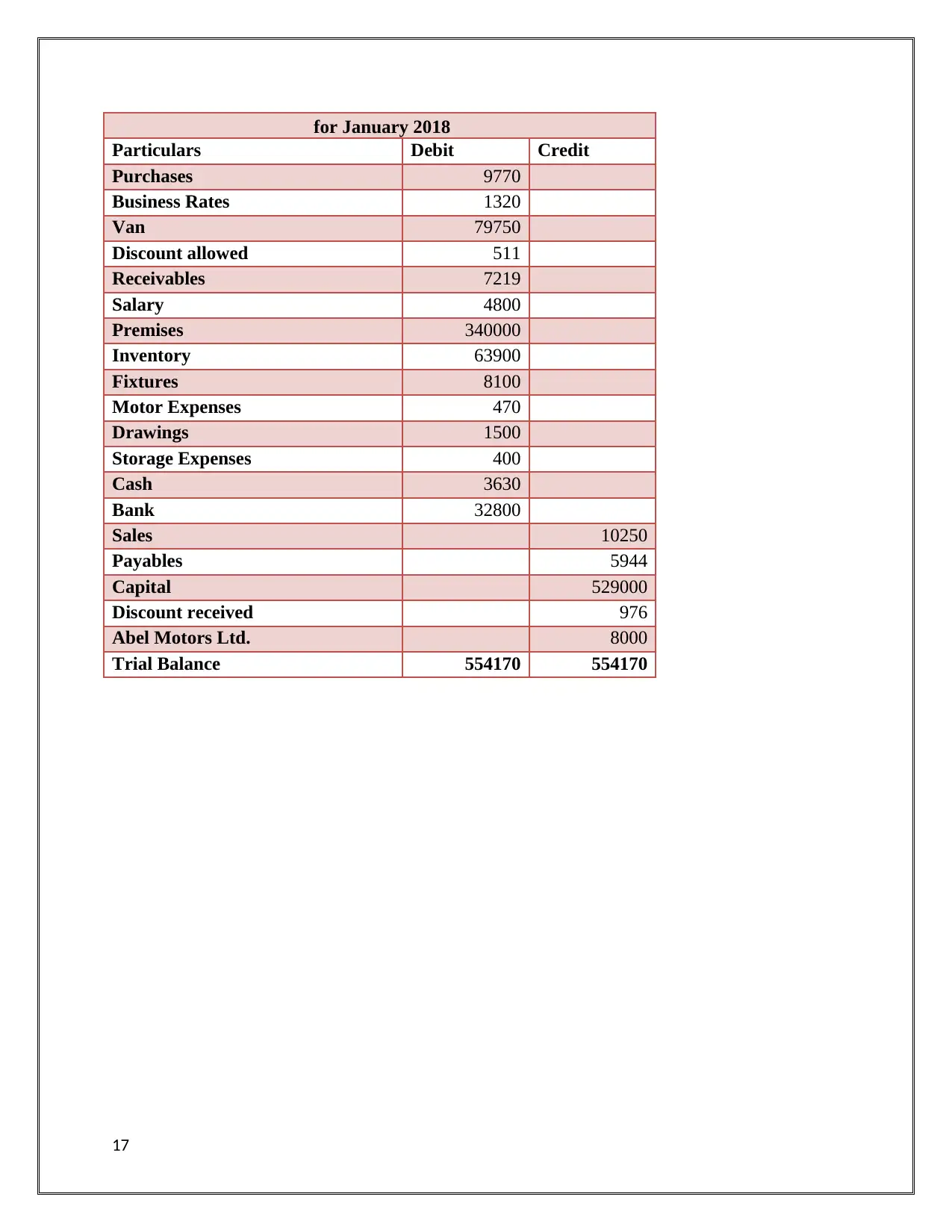
for January 2018
Particulars Debit Credit
Purchases 9770
Business Rates 1320
Van 79750
Discount allowed 511
Receivables 7219
Salary 4800
Premises 340000
Inventory 63900
Fixtures 8100
Motor Expenses 470
Drawings 1500
Storage Expenses 400
Cash 3630
Bank 32800
Sales 10250
Payables 5944
Capital 529000
Discount received 976
Abel Motors Ltd. 8000
Trial Balance 554170 554170
17
Particulars Debit Credit
Purchases 9770
Business Rates 1320
Van 79750
Discount allowed 511
Receivables 7219
Salary 4800
Premises 340000
Inventory 63900
Fixtures 8100
Motor Expenses 470
Drawings 1500
Storage Expenses 400
Cash 3630
Bank 32800
Sales 10250
Payables 5944
Capital 529000
Discount received 976
Abel Motors Ltd. 8000
Trial Balance 554170 554170
17

Client 2
A. Statement of Profit and Loss for Peter Pieper for the year ended 31st December
2017.
Trading and Profit & Loss Account of Peter Piper
For the year ended 31 December 2017
Particular Amount Particular Amount
To Opening Inventory 82200 By Sales 1215000
To Purchases 778800 By Closing Inventory 101640
To Gross profit c/d 455640
Total 1316640 Total 1316640
To wages and salaries 178720 By Gross Profit b/d 455640
To Motor Expenses 87400
To administrative expenses 17650
To Advertising Expenses 4810
To Heating and lightening Expenses 4950
To depreciation on premises 5400
To Depreciation on equipment 17250
To Depreciation on Motor Vehicle 2800
To Net Profit c/d 136660
Total 455640 Total 455640
B. The statement of financial position as at 31st December 2017
Balance Sheet
As at 31st December 2017
Liabilities Amount Assets Amount
Capital 332120 Prepaid advertising expenses 8470
Less: Drawings 42640 Cash in Hand 2440
Add: Net profit 136660 Freehold Premises 227100
426140 Equipments 57750
Payables 76910 Motor 11200
Bank Overdraft 11290 Closing stock 101640
Outstanding Salaries 1220 Receivables 106960
Total 515560 Total 515560
18
A. Statement of Profit and Loss for Peter Pieper for the year ended 31st December
2017.
Trading and Profit & Loss Account of Peter Piper
For the year ended 31 December 2017
Particular Amount Particular Amount
To Opening Inventory 82200 By Sales 1215000
To Purchases 778800 By Closing Inventory 101640
To Gross profit c/d 455640
Total 1316640 Total 1316640
To wages and salaries 178720 By Gross Profit b/d 455640
To Motor Expenses 87400
To administrative expenses 17650
To Advertising Expenses 4810
To Heating and lightening Expenses 4950
To depreciation on premises 5400
To Depreciation on equipment 17250
To Depreciation on Motor Vehicle 2800
To Net Profit c/d 136660
Total 455640 Total 455640
B. The statement of financial position as at 31st December 2017
Balance Sheet
As at 31st December 2017
Liabilities Amount Assets Amount
Capital 332120 Prepaid advertising expenses 8470
Less: Drawings 42640 Cash in Hand 2440
Add: Net profit 136660 Freehold Premises 227100
426140 Equipments 57750
Payables 76910 Motor 11200
Bank Overdraft 11290 Closing stock 101640
Outstanding Salaries 1220 Receivables 106960
Total 515560 Total 515560
18
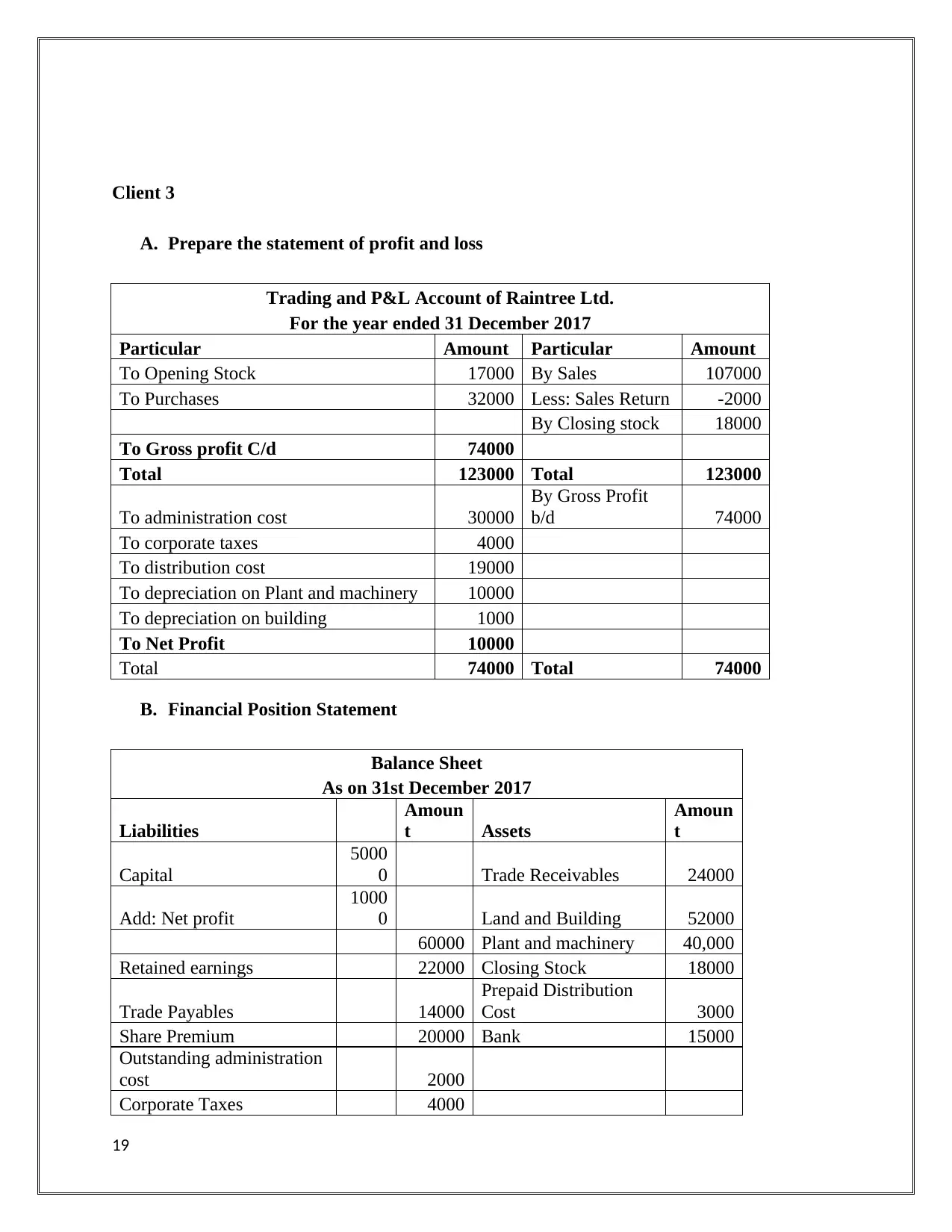
Client 3
A. Prepare the statement of profit and loss
Trading and P&L Account of Raintree Ltd.
For the year ended 31 December 2017
Particular Amount Particular Amount
To Opening Stock 17000 By Sales 107000
To Purchases 32000 Less: Sales Return -2000
By Closing stock 18000
To Gross profit C/d 74000
Total 123000 Total 123000
To administration cost 30000
By Gross Profit
b/d 74000
To corporate taxes 4000
To distribution cost 19000
To depreciation on Plant and machinery 10000
To depreciation on building 1000
To Net Profit 10000
Total 74000 Total 74000
B. Financial Position Statement
Balance Sheet
As on 31st December 2017
Liabilities
Amoun
t Assets
Amoun
t
Capital
5000
0 Trade Receivables 24000
Add: Net profit
1000
0 Land and Building 52000
60000 Plant and machinery 40,000
Retained earnings 22000 Closing Stock 18000
Trade Payables 14000
Prepaid Distribution
Cost 3000
Share Premium 20000 Bank 15000
Outstanding administration
cost 2000
Corporate Taxes 4000
19
A. Prepare the statement of profit and loss
Trading and P&L Account of Raintree Ltd.
For the year ended 31 December 2017
Particular Amount Particular Amount
To Opening Stock 17000 By Sales 107000
To Purchases 32000 Less: Sales Return -2000
By Closing stock 18000
To Gross profit C/d 74000
Total 123000 Total 123000
To administration cost 30000
By Gross Profit
b/d 74000
To corporate taxes 4000
To distribution cost 19000
To depreciation on Plant and machinery 10000
To depreciation on building 1000
To Net Profit 10000
Total 74000 Total 74000
B. Financial Position Statement
Balance Sheet
As on 31st December 2017
Liabilities
Amoun
t Assets
Amoun
t
Capital
5000
0 Trade Receivables 24000
Add: Net profit
1000
0 Land and Building 52000
60000 Plant and machinery 40,000
Retained earnings 22000 Closing Stock 18000
Trade Payables 14000
Prepaid Distribution
Cost 3000
Share Premium 20000 Bank 15000
Outstanding administration
cost 2000
Corporate Taxes 4000
19
Paraphrase This Document
Need a fresh take? Get an instant paraphrase of this document with our AI Paraphraser
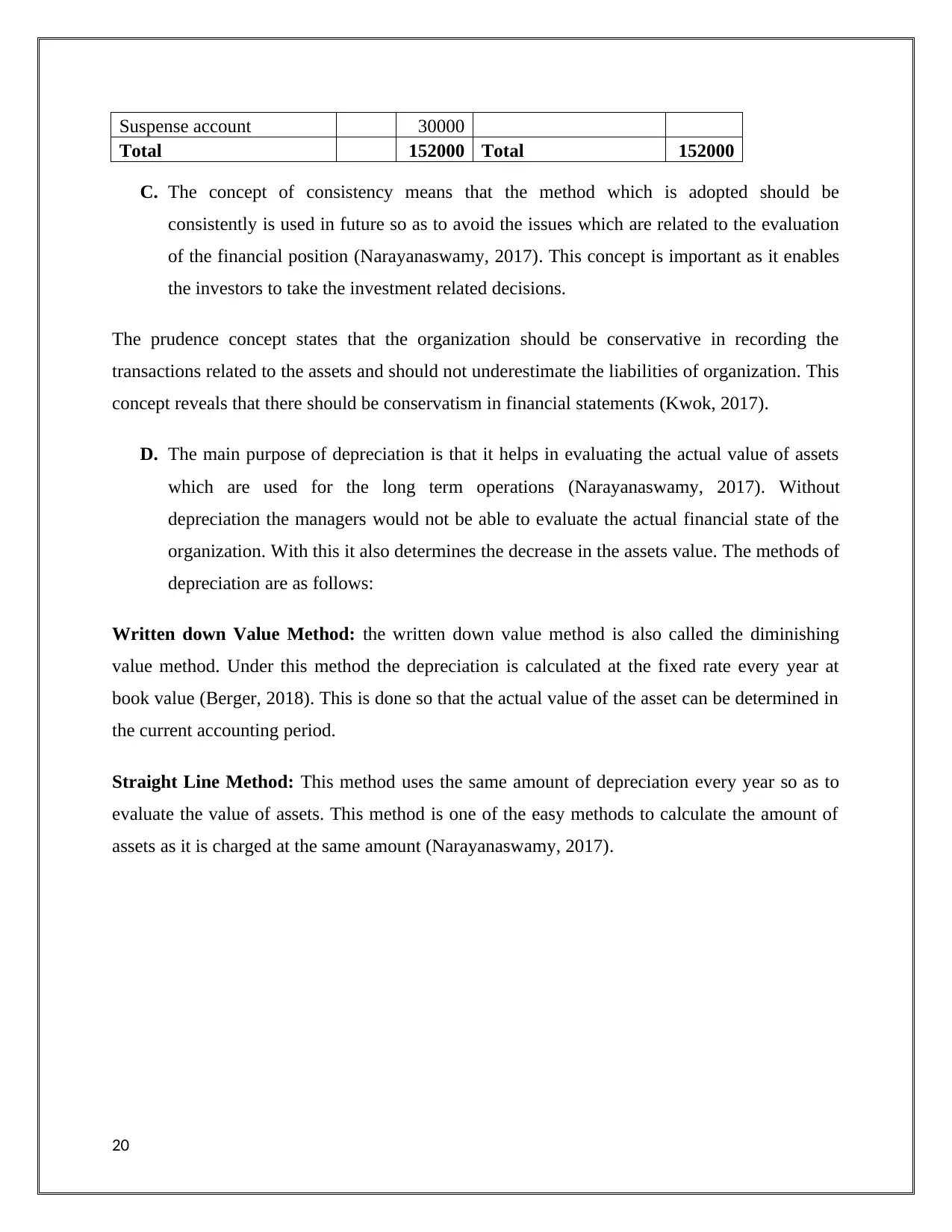
Suspense account 30000
Total 152000 Total 152000
C. The concept of consistency means that the method which is adopted should be
consistently is used in future so as to avoid the issues which are related to the evaluation
of the financial position (Narayanaswamy, 2017). This concept is important as it enables
the investors to take the investment related decisions.
The prudence concept states that the organization should be conservative in recording the
transactions related to the assets and should not underestimate the liabilities of organization. This
concept reveals that there should be conservatism in financial statements (Kwok, 2017).
D. The main purpose of depreciation is that it helps in evaluating the actual value of assets
which are used for the long term operations (Narayanaswamy, 2017). Without
depreciation the managers would not be able to evaluate the actual financial state of the
organization. With this it also determines the decrease in the assets value. The methods of
depreciation are as follows:
Written down Value Method: the written down value method is also called the diminishing
value method. Under this method the depreciation is calculated at the fixed rate every year at
book value (Berger, 2018). This is done so that the actual value of the asset can be determined in
the current accounting period.
Straight Line Method: This method uses the same amount of depreciation every year so as to
evaluate the value of assets. This method is one of the easy methods to calculate the amount of
assets as it is charged at the same amount (Narayanaswamy, 2017).
20
Total 152000 Total 152000
C. The concept of consistency means that the method which is adopted should be
consistently is used in future so as to avoid the issues which are related to the evaluation
of the financial position (Narayanaswamy, 2017). This concept is important as it enables
the investors to take the investment related decisions.
The prudence concept states that the organization should be conservative in recording the
transactions related to the assets and should not underestimate the liabilities of organization. This
concept reveals that there should be conservatism in financial statements (Kwok, 2017).
D. The main purpose of depreciation is that it helps in evaluating the actual value of assets
which are used for the long term operations (Narayanaswamy, 2017). Without
depreciation the managers would not be able to evaluate the actual financial state of the
organization. With this it also determines the decrease in the assets value. The methods of
depreciation are as follows:
Written down Value Method: the written down value method is also called the diminishing
value method. Under this method the depreciation is calculated at the fixed rate every year at
book value (Berger, 2018). This is done so that the actual value of the asset can be determined in
the current accounting period.
Straight Line Method: This method uses the same amount of depreciation every year so as to
evaluate the value of assets. This method is one of the easy methods to calculate the amount of
assets as it is charged at the same amount (Narayanaswamy, 2017).
20
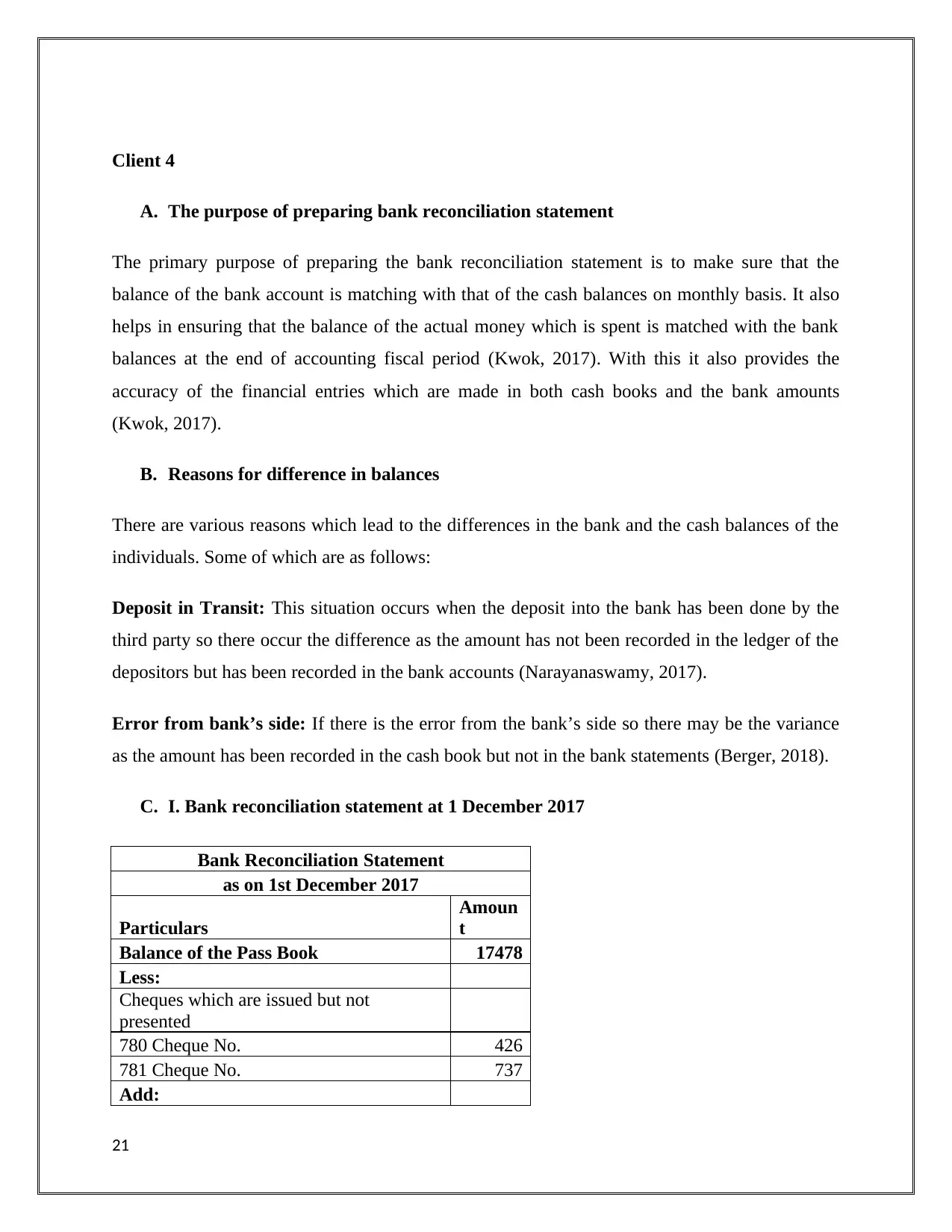
Client 4
A. The purpose of preparing bank reconciliation statement
The primary purpose of preparing the bank reconciliation statement is to make sure that the
balance of the bank account is matching with that of the cash balances on monthly basis. It also
helps in ensuring that the balance of the actual money which is spent is matched with the bank
balances at the end of accounting fiscal period (Kwok, 2017). With this it also provides the
accuracy of the financial entries which are made in both cash books and the bank amounts
(Kwok, 2017).
B. Reasons for difference in balances
There are various reasons which lead to the differences in the bank and the cash balances of the
individuals. Some of which are as follows:
Deposit in Transit: This situation occurs when the deposit into the bank has been done by the
third party so there occur the difference as the amount has not been recorded in the ledger of the
depositors but has been recorded in the bank accounts (Narayanaswamy, 2017).
Error from bank’s side: If there is the error from the bank’s side so there may be the variance
as the amount has been recorded in the cash book but not in the bank statements (Berger, 2018).
C. I. Bank reconciliation statement at 1 December 2017
Bank Reconciliation Statement
as on 1st December 2017
Particulars
Amoun
t
Balance of the Pass Book 17478
Less:
Cheques which are issued but not
presented
780 Cheque No. 426
781 Cheque No. 737
Add:
21
A. The purpose of preparing bank reconciliation statement
The primary purpose of preparing the bank reconciliation statement is to make sure that the
balance of the bank account is matching with that of the cash balances on monthly basis. It also
helps in ensuring that the balance of the actual money which is spent is matched with the bank
balances at the end of accounting fiscal period (Kwok, 2017). With this it also provides the
accuracy of the financial entries which are made in both cash books and the bank amounts
(Kwok, 2017).
B. Reasons for difference in balances
There are various reasons which lead to the differences in the bank and the cash balances of the
individuals. Some of which are as follows:
Deposit in Transit: This situation occurs when the deposit into the bank has been done by the
third party so there occur the difference as the amount has not been recorded in the ledger of the
depositors but has been recorded in the bank accounts (Narayanaswamy, 2017).
Error from bank’s side: If there is the error from the bank’s side so there may be the variance
as the amount has been recorded in the cash book but not in the bank statements (Berger, 2018).
C. I. Bank reconciliation statement at 1 December 2017
Bank Reconciliation Statement
as on 1st December 2017
Particulars
Amoun
t
Balance of the Pass Book 17478
Less:
Cheques which are issued but not
presented
780 Cheque No. 426
781 Cheque No. 737
Add:
21
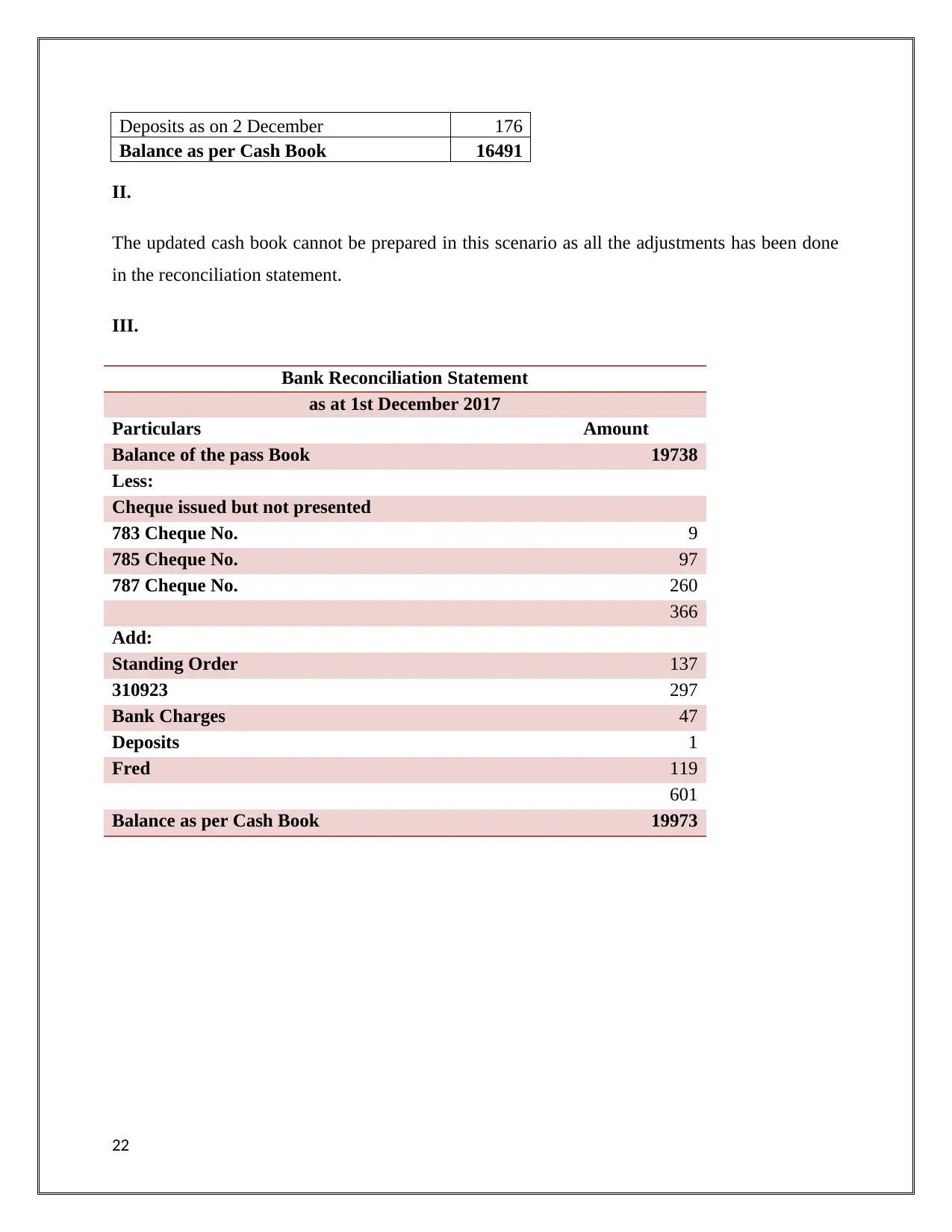
Deposits as on 2 December 176
Balance as per Cash Book 16491
II.
The updated cash book cannot be prepared in this scenario as all the adjustments has been done
in the reconciliation statement.
III.
Bank Reconciliation Statement
as at 1st December 2017
Particulars Amount
Balance of the pass Book 19738
Less:
Cheque issued but not presented
783 Cheque No. 9
785 Cheque No. 97
787 Cheque No. 260
366
Add:
Standing Order 137
310923 297
Bank Charges 47
Deposits 1
Fred 119
601
Balance as per Cash Book 19973
22
Balance as per Cash Book 16491
II.
The updated cash book cannot be prepared in this scenario as all the adjustments has been done
in the reconciliation statement.
III.
Bank Reconciliation Statement
as at 1st December 2017
Particulars Amount
Balance of the pass Book 19738
Less:
Cheque issued but not presented
783 Cheque No. 9
785 Cheque No. 97
787 Cheque No. 260
366
Add:
Standing Order 137
310923 297
Bank Charges 47
Deposits 1
Fred 119
601
Balance as per Cash Book 19973
22
Secure Best Marks with AI Grader
Need help grading? Try our AI Grader for instant feedback on your assignments.
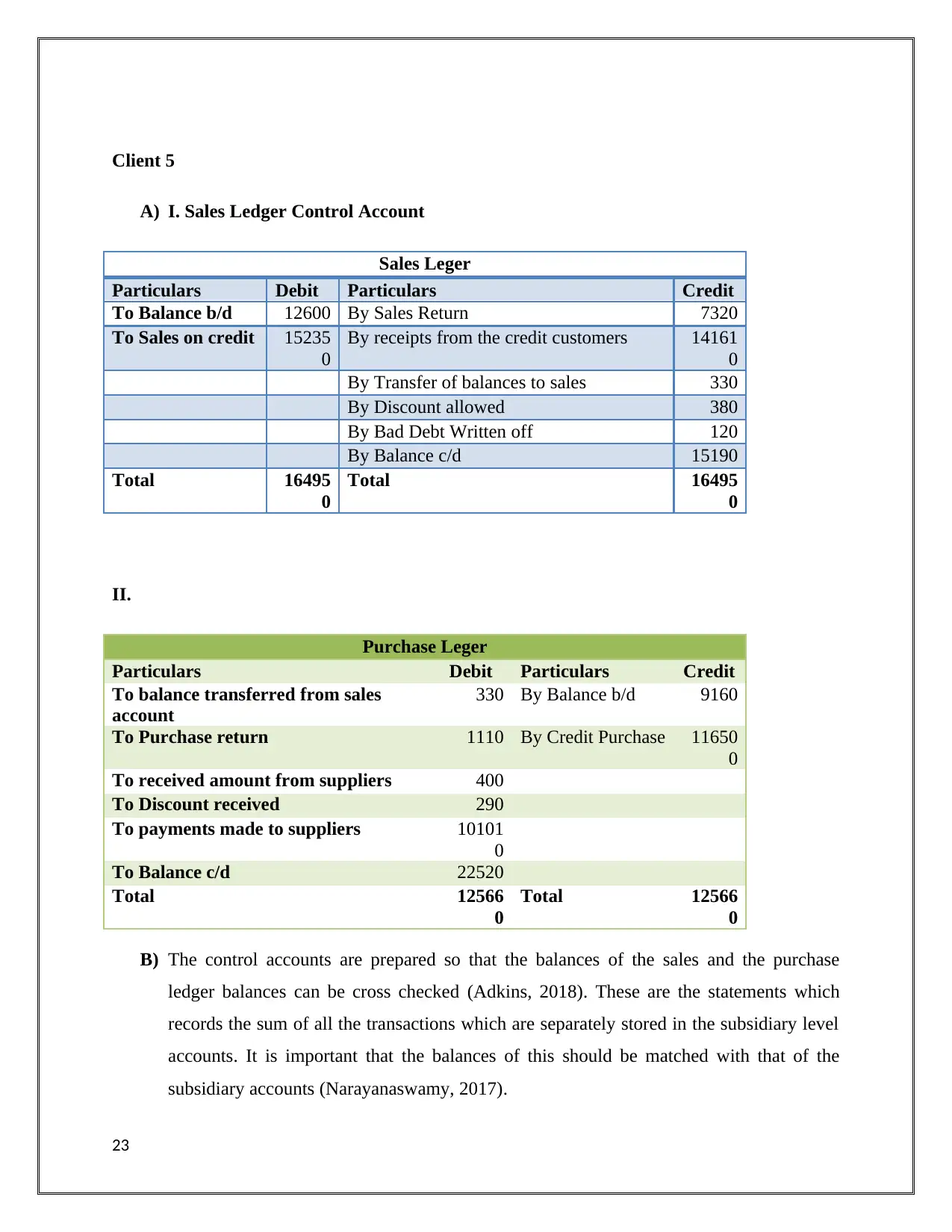
Client 5
A) I. Sales Ledger Control Account
Sales Leger
Particulars Debit Particulars Credit
To Balance b/d 12600 By Sales Return 7320
To Sales on credit 15235
0
By receipts from the credit customers 14161
0
By Transfer of balances to sales 330
By Discount allowed 380
By Bad Debt Written off 120
By Balance c/d 15190
Total 16495
0
Total 16495
0
II.
Purchase Leger
Particulars Debit Particulars Credit
To balance transferred from sales
account
330 By Balance b/d 9160
To Purchase return 1110 By Credit Purchase 11650
0
To received amount from suppliers 400
To Discount received 290
To payments made to suppliers 10101
0
To Balance c/d 22520
Total 12566
0
Total 12566
0
B) The control accounts are prepared so that the balances of the sales and the purchase
ledger balances can be cross checked (Adkins, 2018). These are the statements which
records the sum of all the transactions which are separately stored in the subsidiary level
accounts. It is important that the balances of this should be matched with that of the
subsidiary accounts (Narayanaswamy, 2017).
23
A) I. Sales Ledger Control Account
Sales Leger
Particulars Debit Particulars Credit
To Balance b/d 12600 By Sales Return 7320
To Sales on credit 15235
0
By receipts from the credit customers 14161
0
By Transfer of balances to sales 330
By Discount allowed 380
By Bad Debt Written off 120
By Balance c/d 15190
Total 16495
0
Total 16495
0
II.
Purchase Leger
Particulars Debit Particulars Credit
To balance transferred from sales
account
330 By Balance b/d 9160
To Purchase return 1110 By Credit Purchase 11650
0
To received amount from suppliers 400
To Discount received 290
To payments made to suppliers 10101
0
To Balance c/d 22520
Total 12566
0
Total 12566
0
B) The control accounts are prepared so that the balances of the sales and the purchase
ledger balances can be cross checked (Adkins, 2018). These are the statements which
records the sum of all the transactions which are separately stored in the subsidiary level
accounts. It is important that the balances of this should be matched with that of the
subsidiary accounts (Narayanaswamy, 2017).
23

24

Client 6
A) The suspense account is the temporary account which is opened so as to balance the
transactions of the accounts (Epstein, 2018). These are those accounts which exist until
the balances are balanced. When the balances or the transactions are recorded in invalid
accounts then the suspense account is opened. Once the proper account for the transaction
is evaluated then the determination about the time of recording is done (Epstein, 2018).
Features of Suspense Accounts
It helps in preparing the trial balances so that the balances of the accounts can be
evaluated.
It also helps in locating the errors and then taking actions accordingly (Adkins, 2018).
It rectifies the errors which are one sided and then transfer that to the suspense accounts.
It also helps in preparation of the final accounts of organization.
B)
Trial Balance
Particulars Debit Credit
Sales 1100
Capital 710
Payables 350
Control A/C 110
Travel Expenses 160
Receivables 320
Purchases 700
Cash in Bank 840
Rent Paid 250
Total 2270 2270
C)
Suspense Account Entries
S.
No.
Particulars Debi
t
Credi
t
1 Simon A/C 220
25
A) The suspense account is the temporary account which is opened so as to balance the
transactions of the accounts (Epstein, 2018). These are those accounts which exist until
the balances are balanced. When the balances or the transactions are recorded in invalid
accounts then the suspense account is opened. Once the proper account for the transaction
is evaluated then the determination about the time of recording is done (Epstein, 2018).
Features of Suspense Accounts
It helps in preparing the trial balances so that the balances of the accounts can be
evaluated.
It also helps in locating the errors and then taking actions accordingly (Adkins, 2018).
It rectifies the errors which are one sided and then transfer that to the suspense accounts.
It also helps in preparation of the final accounts of organization.
B)
Trial Balance
Particulars Debit Credit
Sales 1100
Capital 710
Payables 350
Control A/C 110
Travel Expenses 160
Receivables 320
Purchases 700
Cash in Bank 840
Rent Paid 250
Total 2270 2270
C)
Suspense Account Entries
S.
No.
Particulars Debi
t
Credi
t
1 Simon A/C 220
25
Paraphrase This Document
Need a fresh take? Get an instant paraphrase of this document with our AI Paraphraser
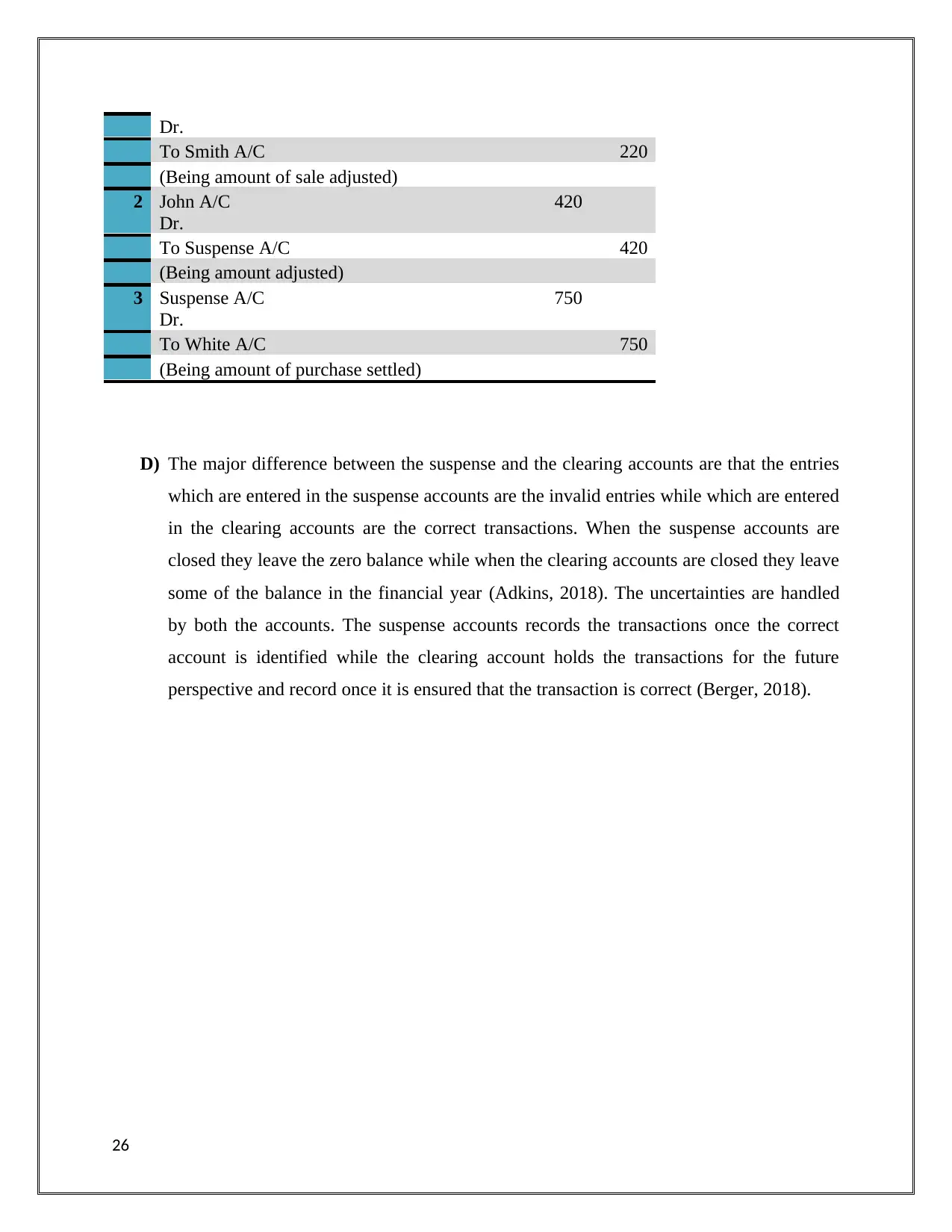
Dr.
To Smith A/C 220
(Being amount of sale adjusted)
2 John A/C
Dr.
420
To Suspense A/C 420
(Being amount adjusted)
3 Suspense A/C
Dr.
750
To White A/C 750
(Being amount of purchase settled)
D) The major difference between the suspense and the clearing accounts are that the entries
which are entered in the suspense accounts are the invalid entries while which are entered
in the clearing accounts are the correct transactions. When the suspense accounts are
closed they leave the zero balance while when the clearing accounts are closed they leave
some of the balance in the financial year (Adkins, 2018). The uncertainties are handled
by both the accounts. The suspense accounts records the transactions once the correct
account is identified while the clearing account holds the transactions for the future
perspective and record once it is ensured that the transaction is correct (Berger, 2018).
26
To Smith A/C 220
(Being amount of sale adjusted)
2 John A/C
Dr.
420
To Suspense A/C 420
(Being amount adjusted)
3 Suspense A/C
Dr.
750
To White A/C 750
(Being amount of purchase settled)
D) The major difference between the suspense and the clearing accounts are that the entries
which are entered in the suspense accounts are the invalid entries while which are entered
in the clearing accounts are the correct transactions. When the suspense accounts are
closed they leave the zero balance while when the clearing accounts are closed they leave
some of the balance in the financial year (Adkins, 2018). The uncertainties are handled
by both the accounts. The suspense accounts records the transactions once the correct
account is identified while the clearing account holds the transactions for the future
perspective and record once it is ensured that the transaction is correct (Berger, 2018).
26

Conclusion
It can be stated from the discussion that the reporting of the transactions is necessary so as to
ensure that the decisions for the long term can be taken accordingly. The journal entries are done
so that the transactions can be journalized and then those transactions are posted in their
respective accounts. The profit & Loss and balance sheet is prepared so that the financial
performance and the position of the organization can be determined. The reasons for the
preparation of the bank reconciliation statement are highlighted with that the factors which lead
to difference are also determined. The suspense account is also prepared to make the corrections
in the entries which are wrongly posted in their accounts so that the correct financial status of the
organization can be evaluated. Besides, this the report also explains the difference between the
clearing and suspense accounts so that the confusion regarding that can be cleared.
27
It can be stated from the discussion that the reporting of the transactions is necessary so as to
ensure that the decisions for the long term can be taken accordingly. The journal entries are done
so that the transactions can be journalized and then those transactions are posted in their
respective accounts. The profit & Loss and balance sheet is prepared so that the financial
performance and the position of the organization can be determined. The reasons for the
preparation of the bank reconciliation statement are highlighted with that the factors which lead
to difference are also determined. The suspense account is also prepared to make the corrections
in the entries which are wrongly posted in their accounts so that the correct financial status of the
organization can be evaluated. Besides, this the report also explains the difference between the
clearing and suspense accounts so that the confusion regarding that can be cleared.
27

Bibliography
Adkins, W. (2018). Retrieved June 12, 2018, from Chron:
http://smallbusiness.chron.com/difference-between-suspense-account-clearing-account-
81560.html
Berger, T. (2018). Ipsas Explained: A Summary of Standards and Principles of
International Public Sector Accounting Standards. John Wiley & Sons .
carrers, N. (2018). Retrieved June 12, 2018, from Ng carrers:
https://ngcareers.com/course/258/financial-accounting
Epstein, L. a. (2018). Optimal Learning under Robustness and Time $ Consistency.
Kwok, B. (2017). Accounting irregularities in financial statements: A definitive guide for
litigators, auditors and fraud investigators. Routledge .
Narayanaswamy, R. (2017). Financial accounting: a managerial perspective. PHI
Learning Pvt. Ltd.
Stockenstrand, A. a. (2017). Bank Regulation: Effects on Strategy, Financial Accounting
and Management Control. Taylor & Francis , 19.
28
Adkins, W. (2018). Retrieved June 12, 2018, from Chron:
http://smallbusiness.chron.com/difference-between-suspense-account-clearing-account-
81560.html
Berger, T. (2018). Ipsas Explained: A Summary of Standards and Principles of
International Public Sector Accounting Standards. John Wiley & Sons .
carrers, N. (2018). Retrieved June 12, 2018, from Ng carrers:
https://ngcareers.com/course/258/financial-accounting
Epstein, L. a. (2018). Optimal Learning under Robustness and Time $ Consistency.
Kwok, B. (2017). Accounting irregularities in financial statements: A definitive guide for
litigators, auditors and fraud investigators. Routledge .
Narayanaswamy, R. (2017). Financial accounting: a managerial perspective. PHI
Learning Pvt. Ltd.
Stockenstrand, A. a. (2017). Bank Regulation: Effects on Strategy, Financial Accounting
and Management Control. Taylor & Francis , 19.
28
1 out of 28
Related Documents
Your All-in-One AI-Powered Toolkit for Academic Success.
+13062052269
info@desklib.com
Available 24*7 on WhatsApp / Email
![[object Object]](/_next/static/media/star-bottom.7253800d.svg)
Unlock your academic potential
© 2024 | Zucol Services PVT LTD | All rights reserved.





